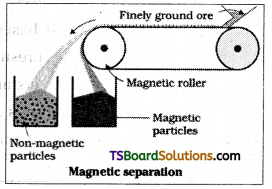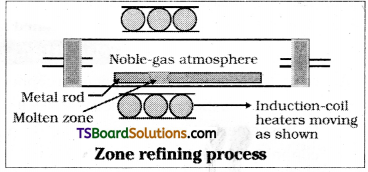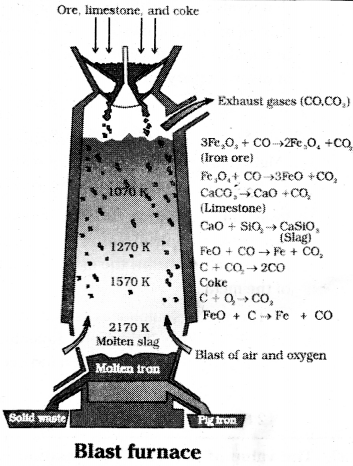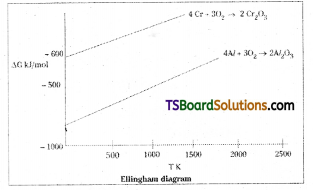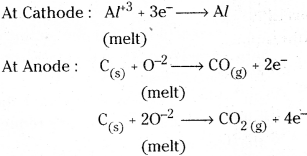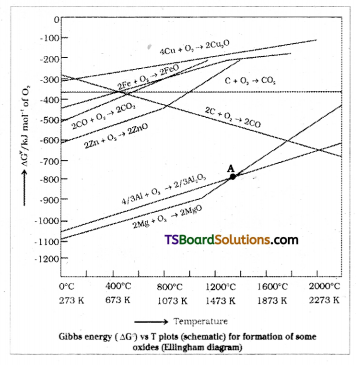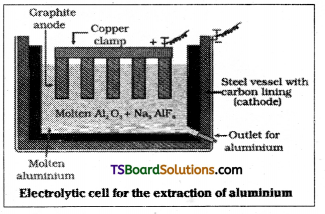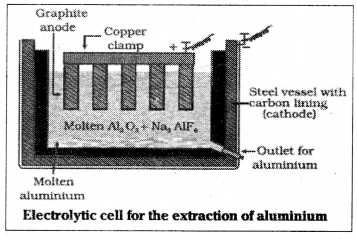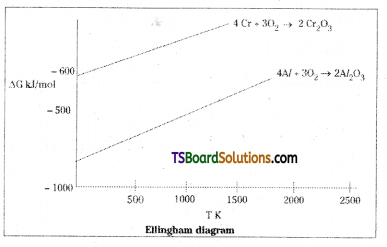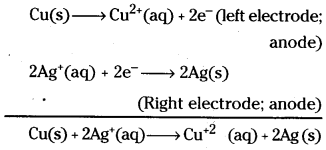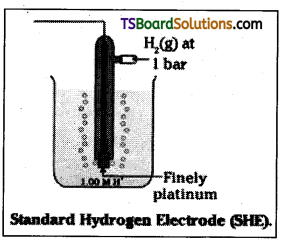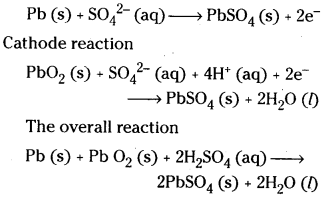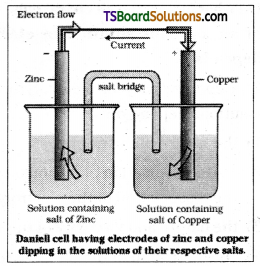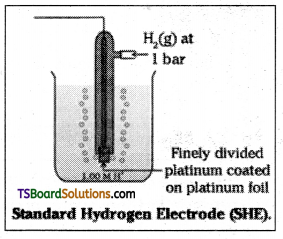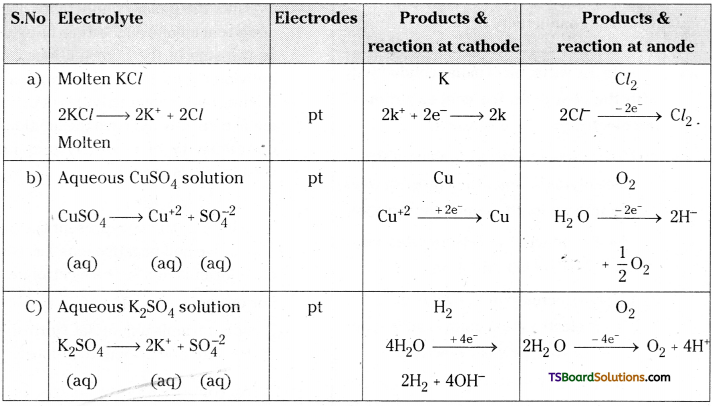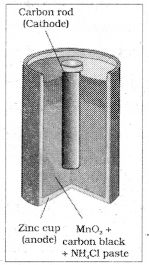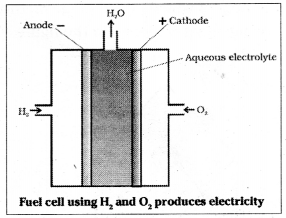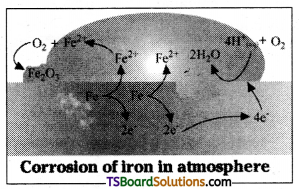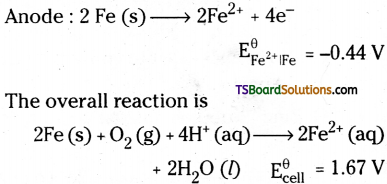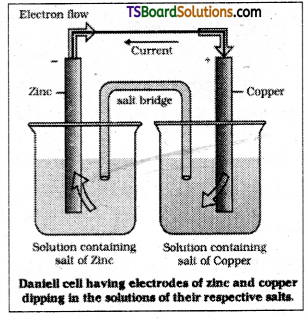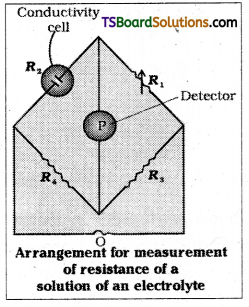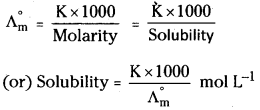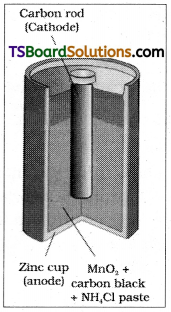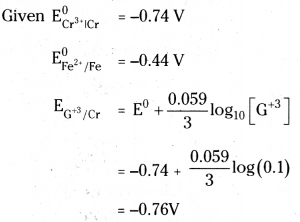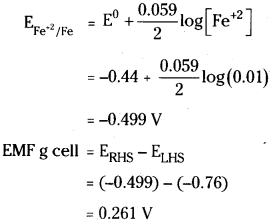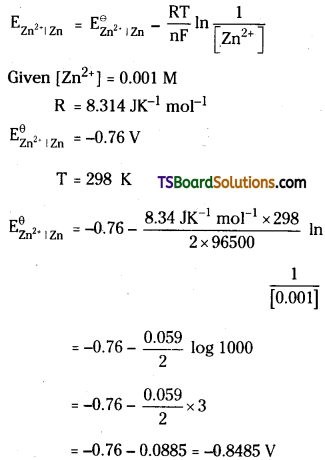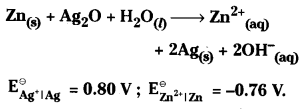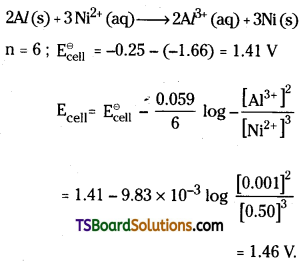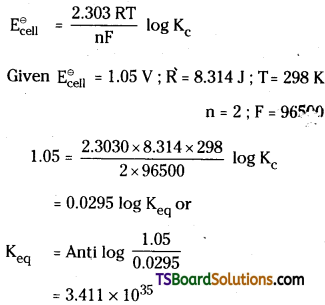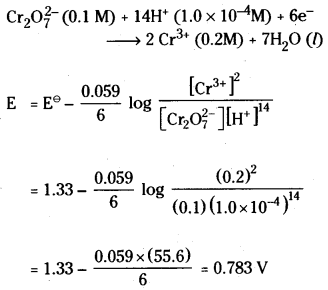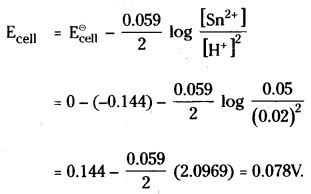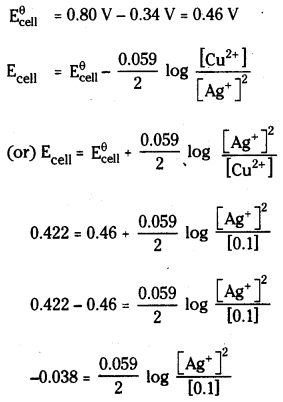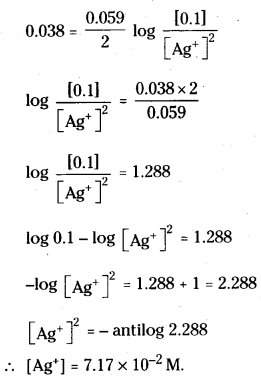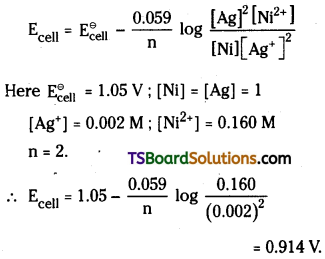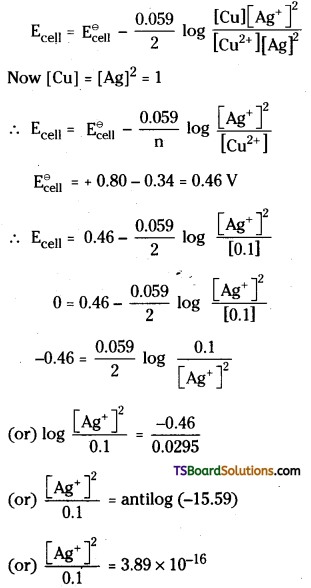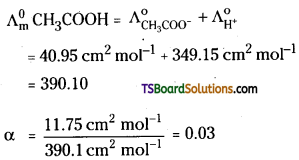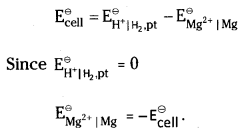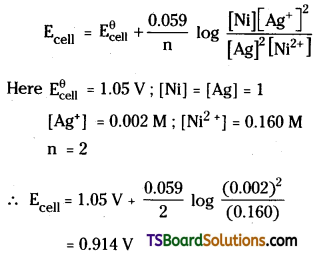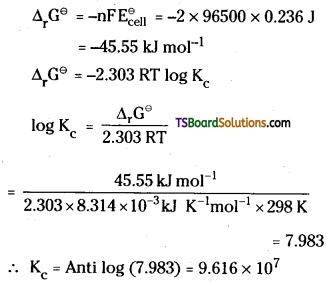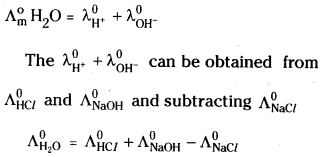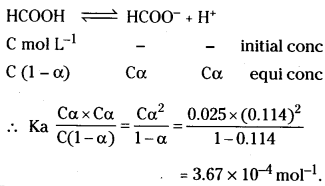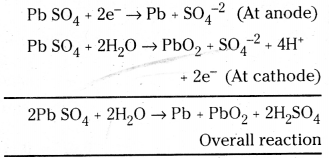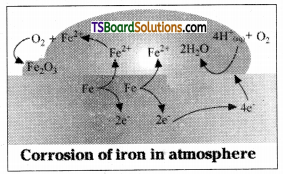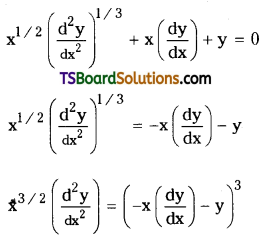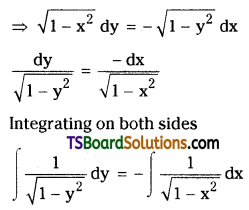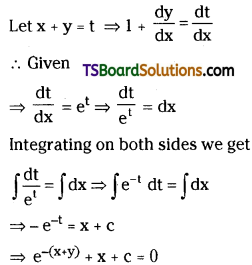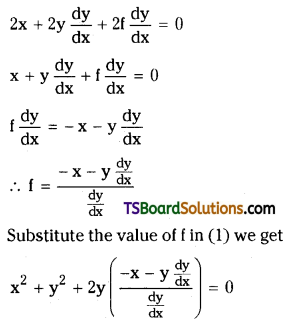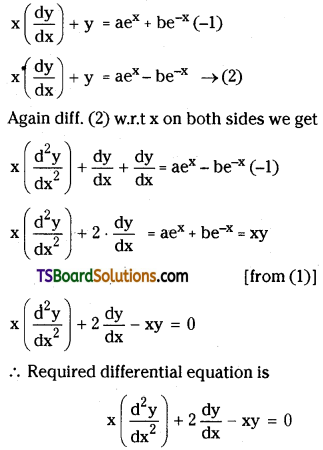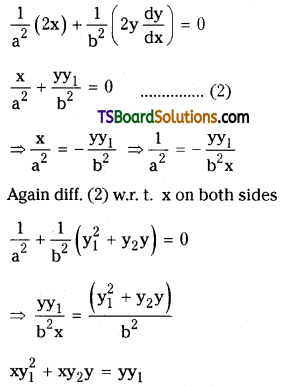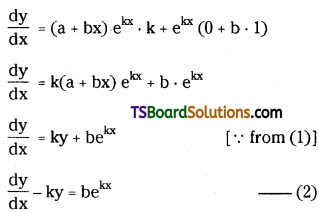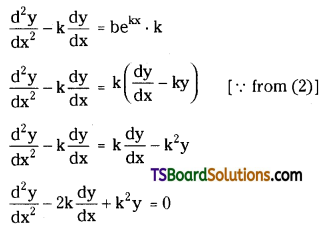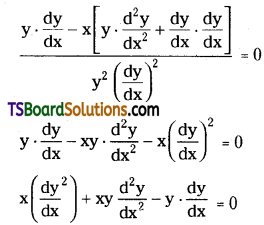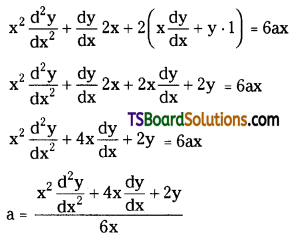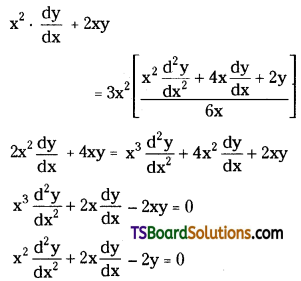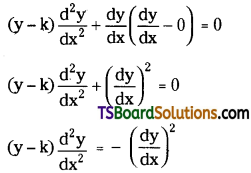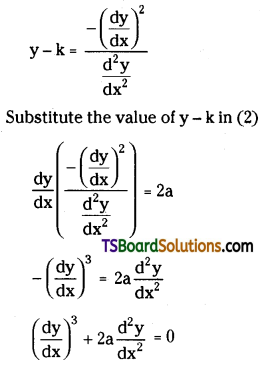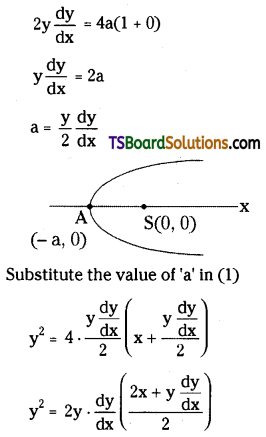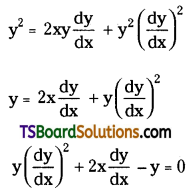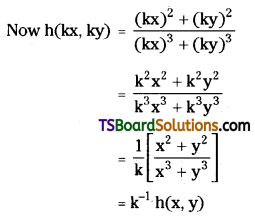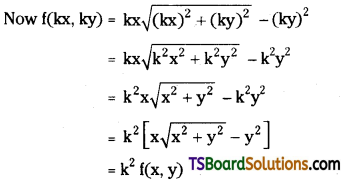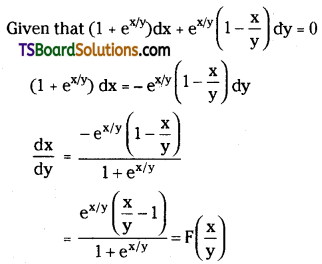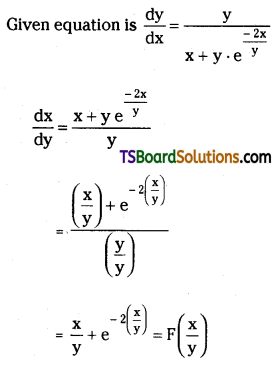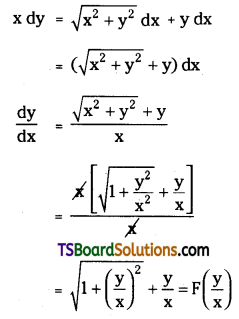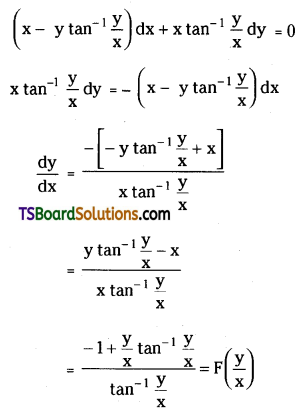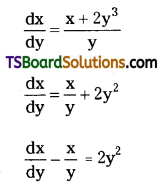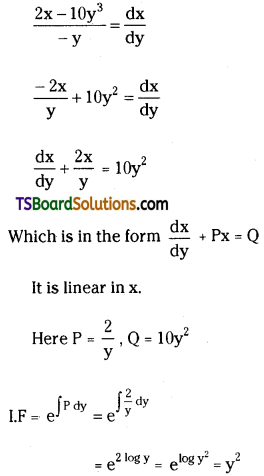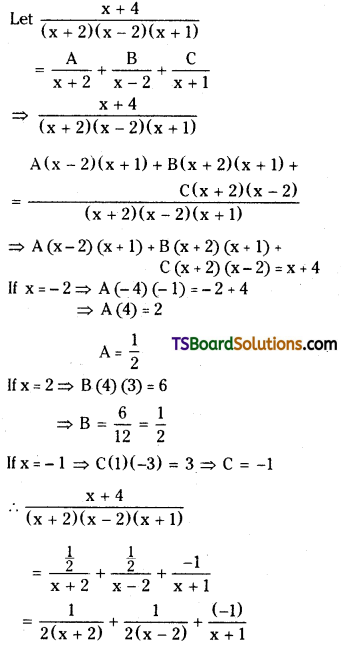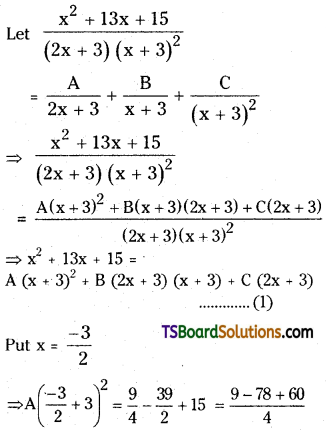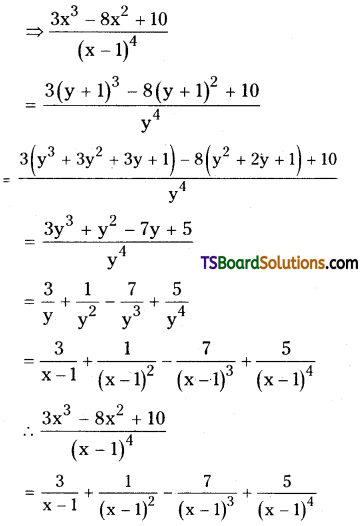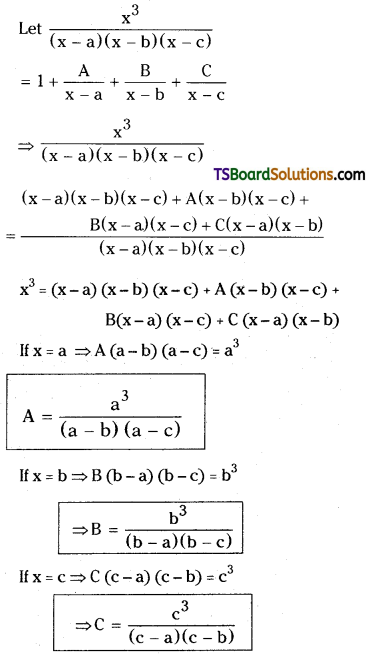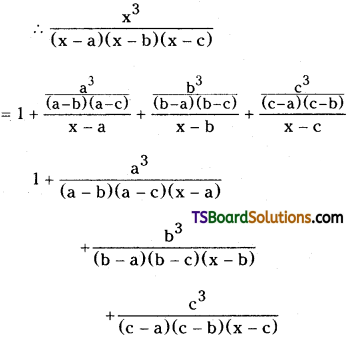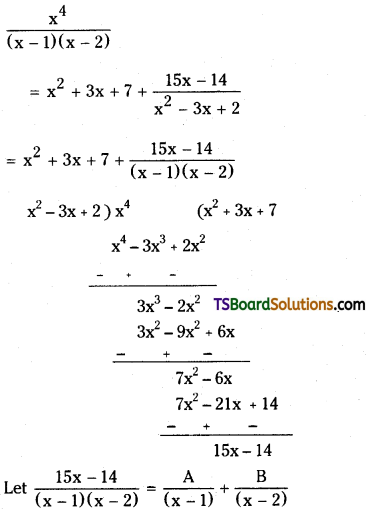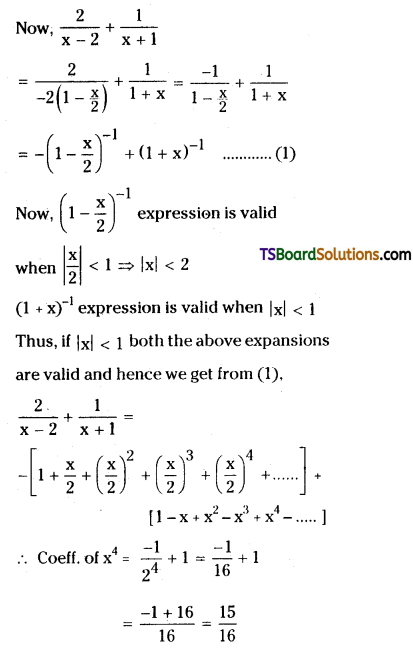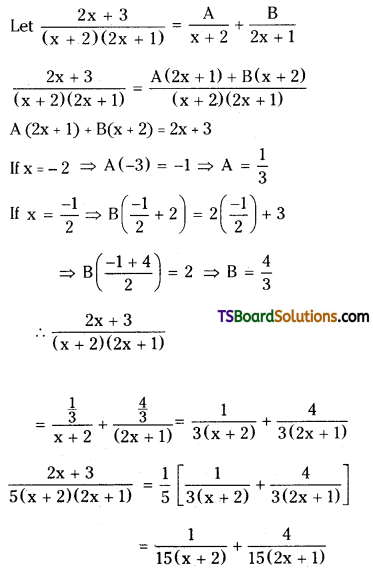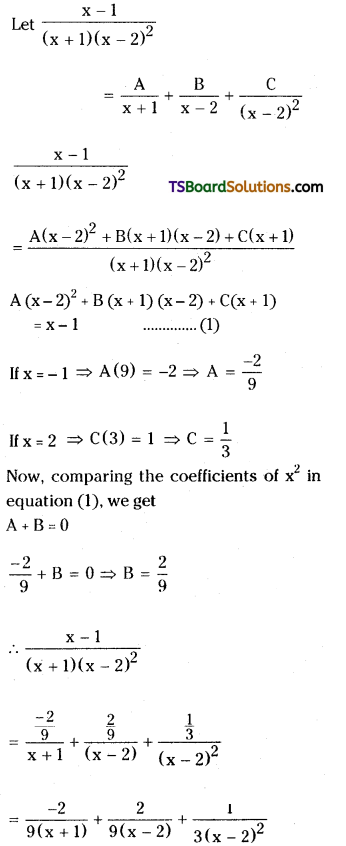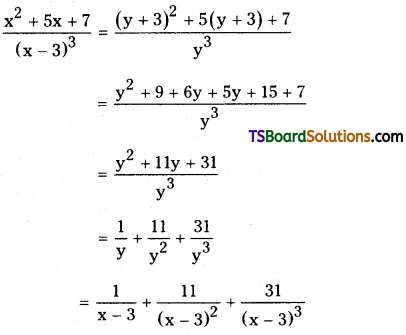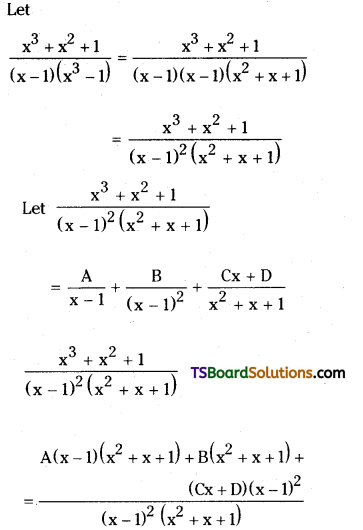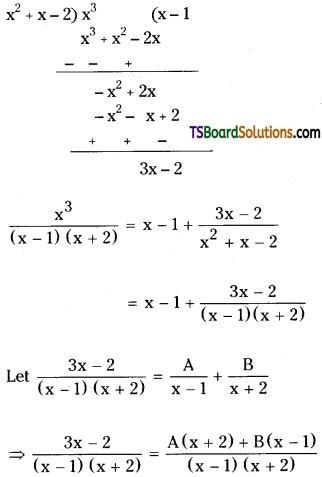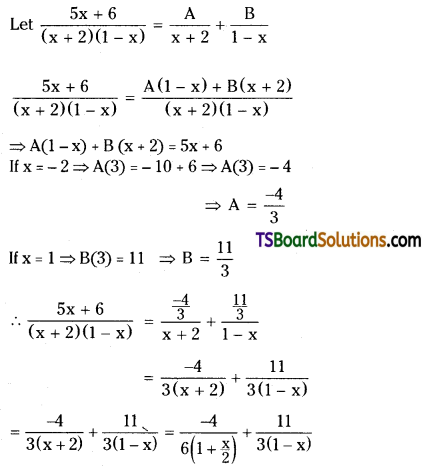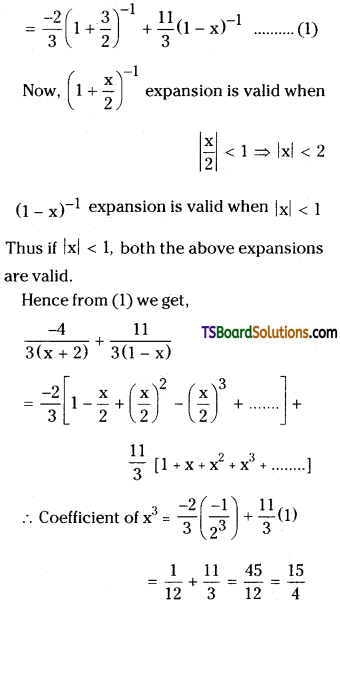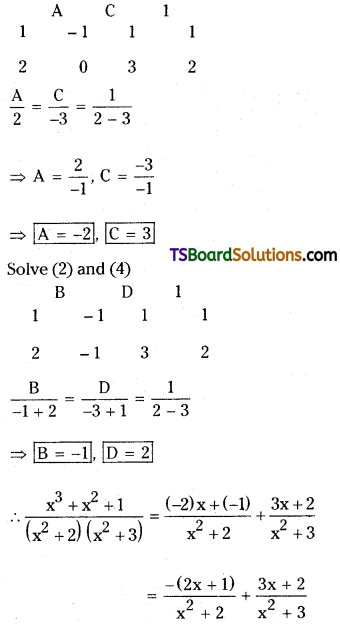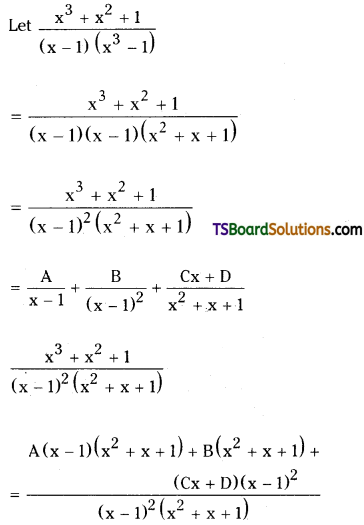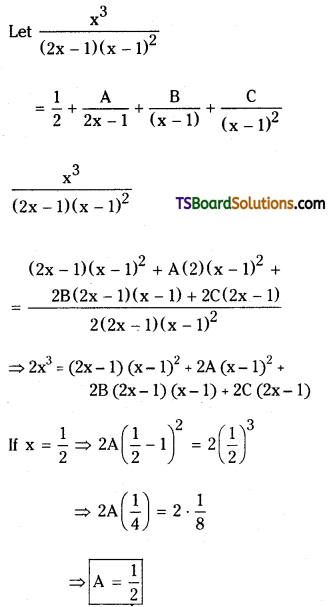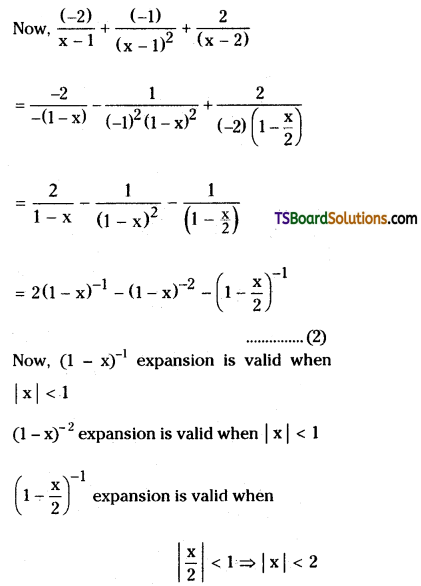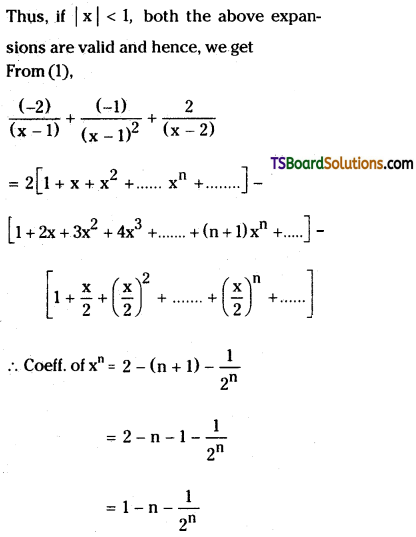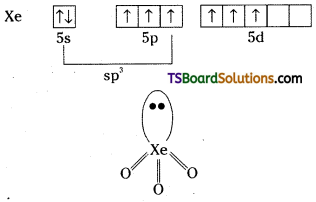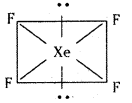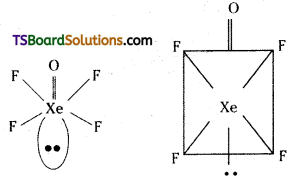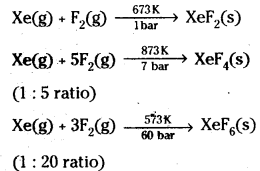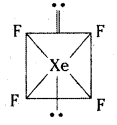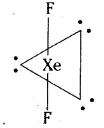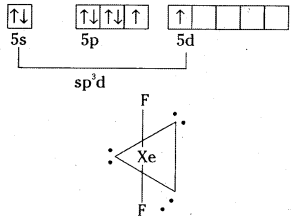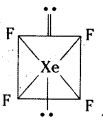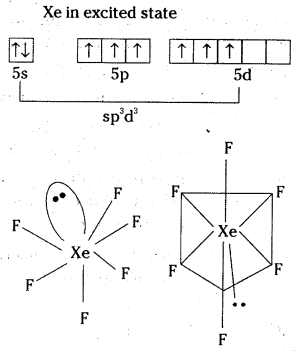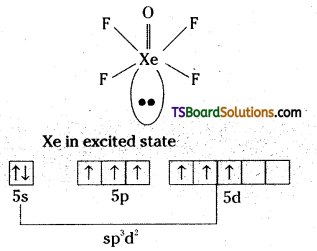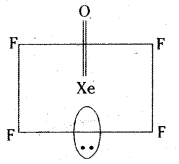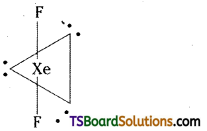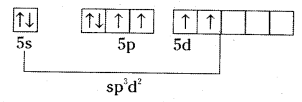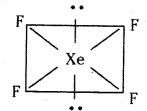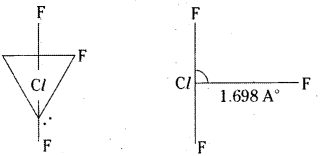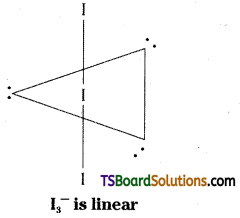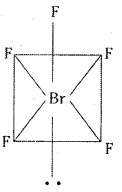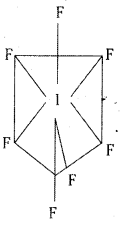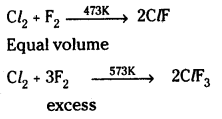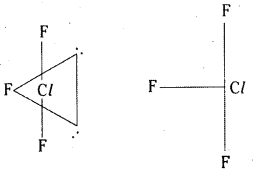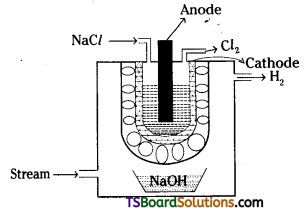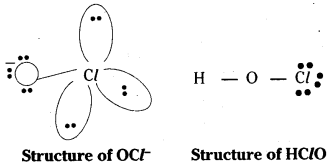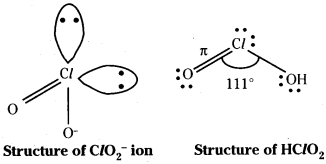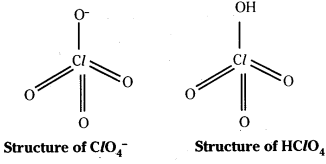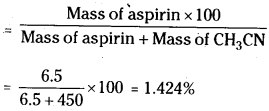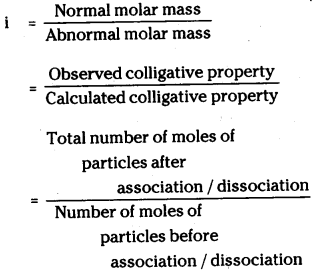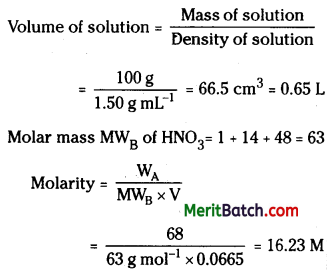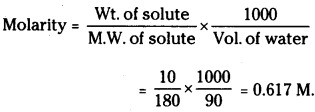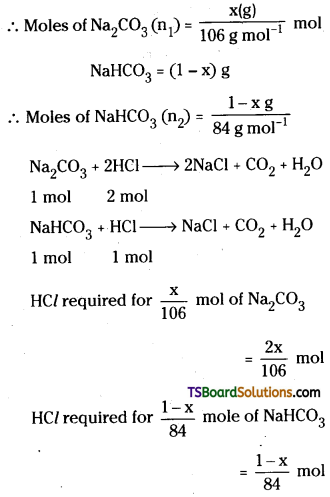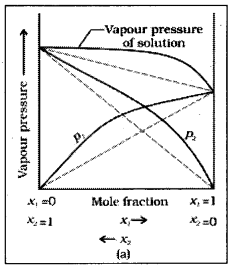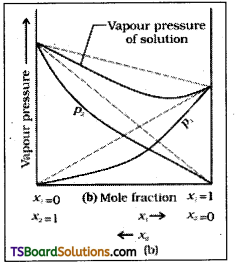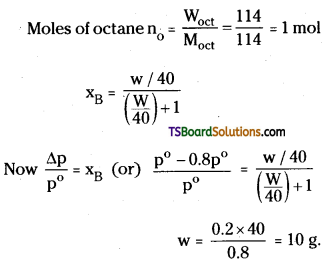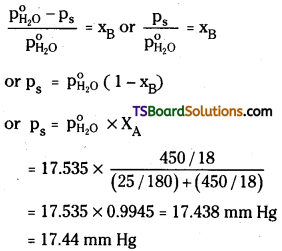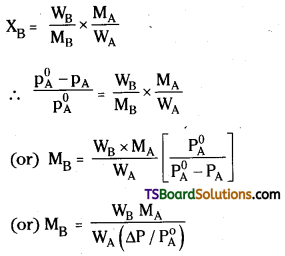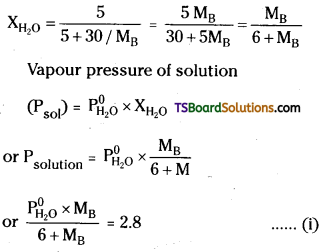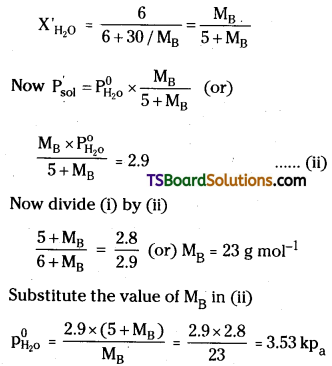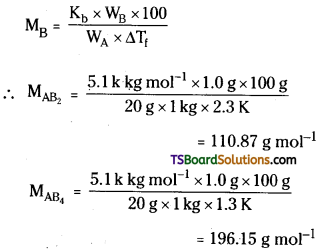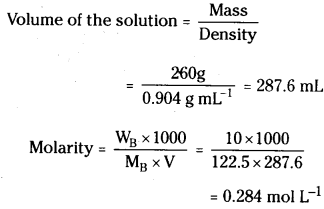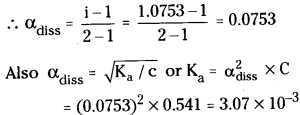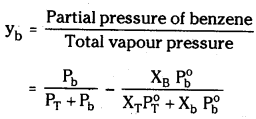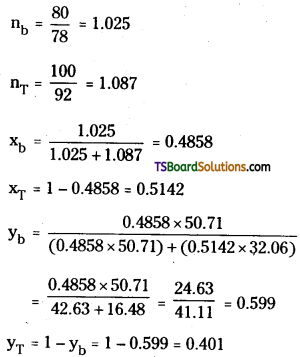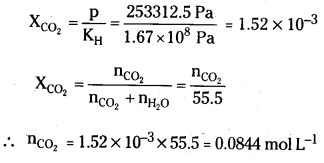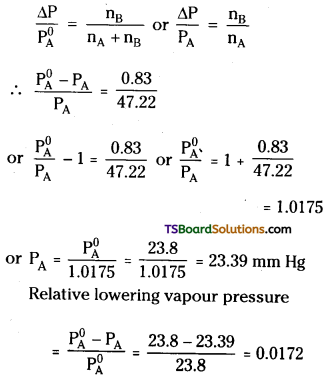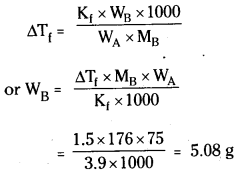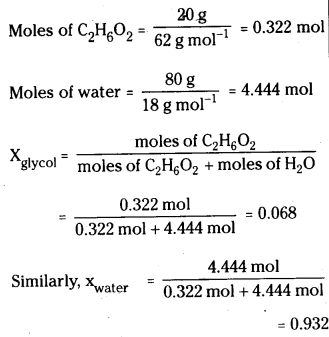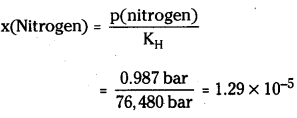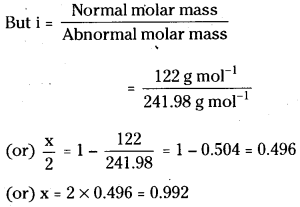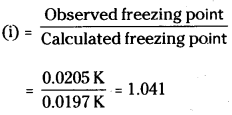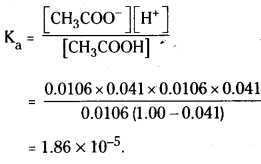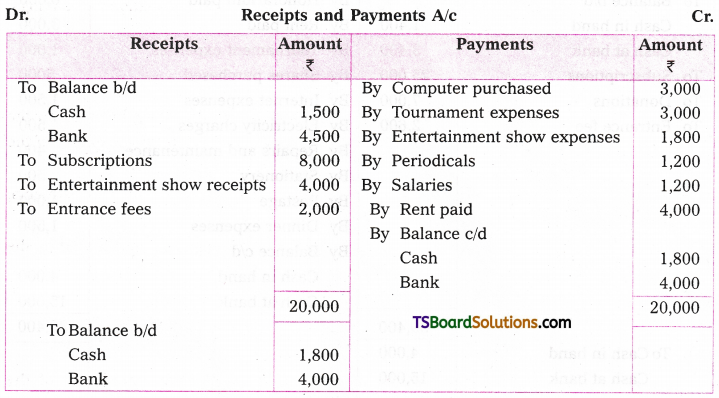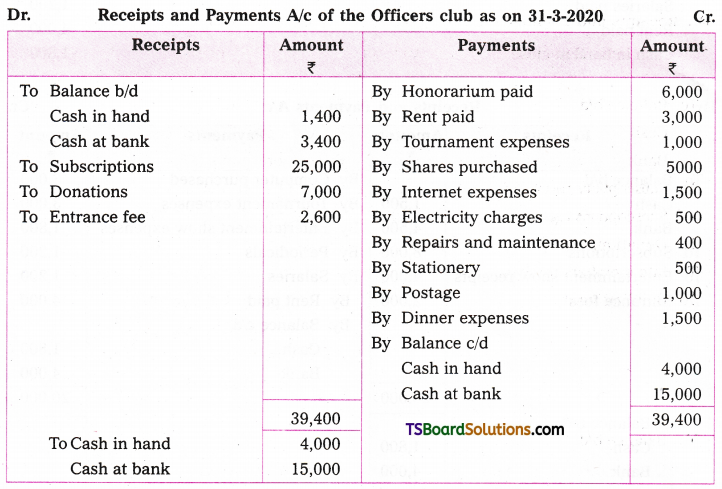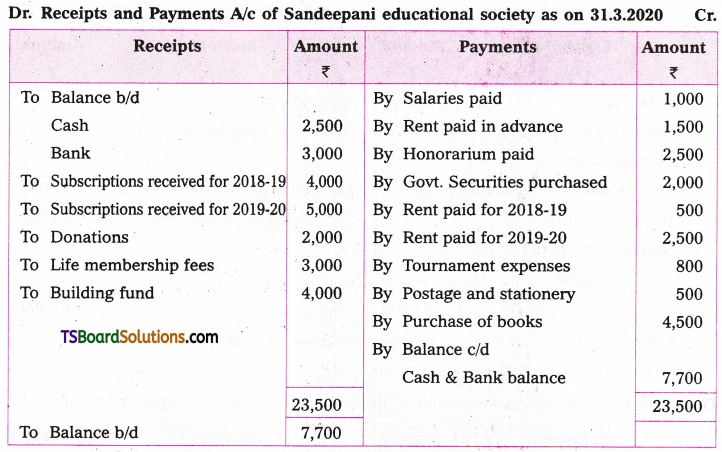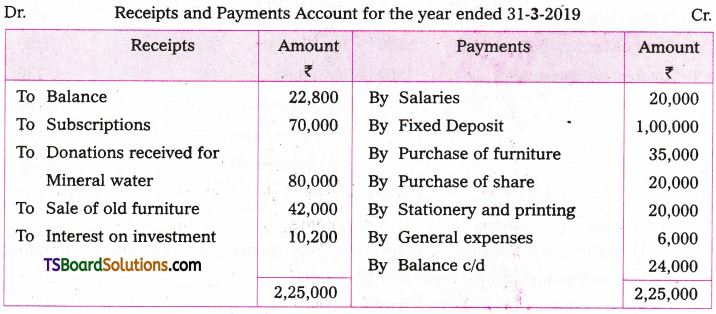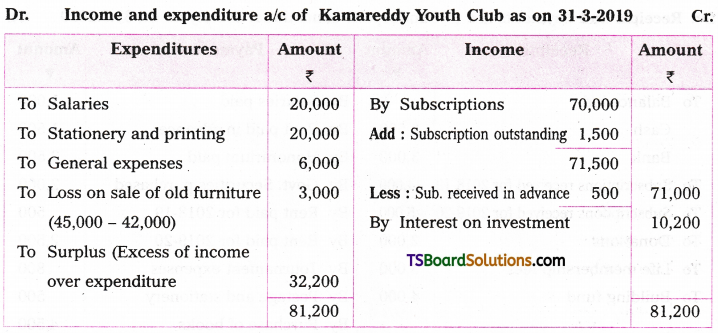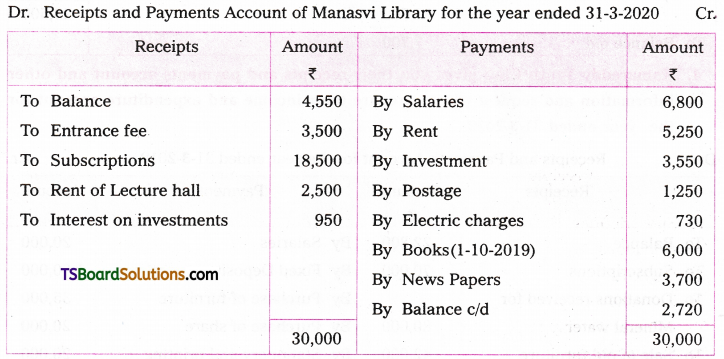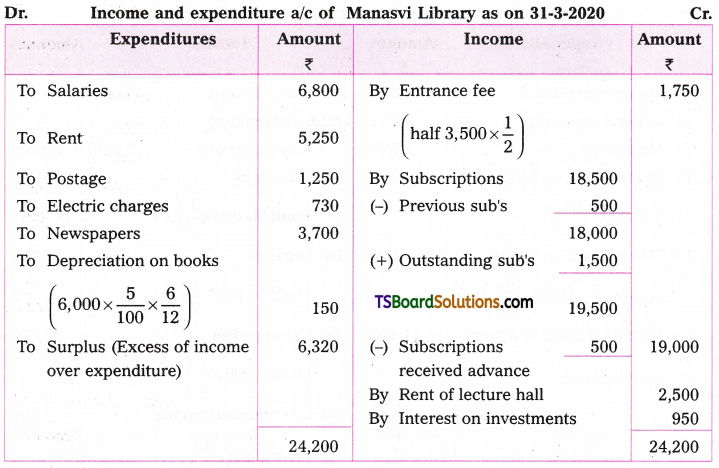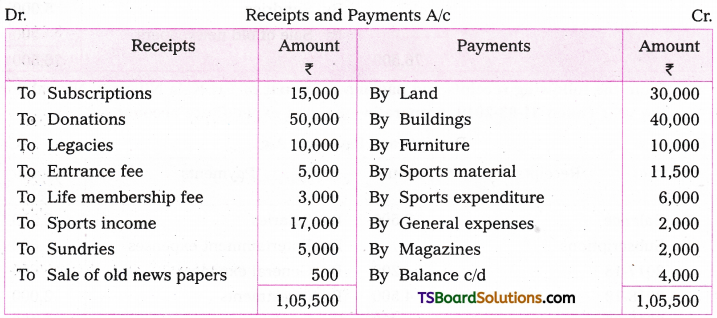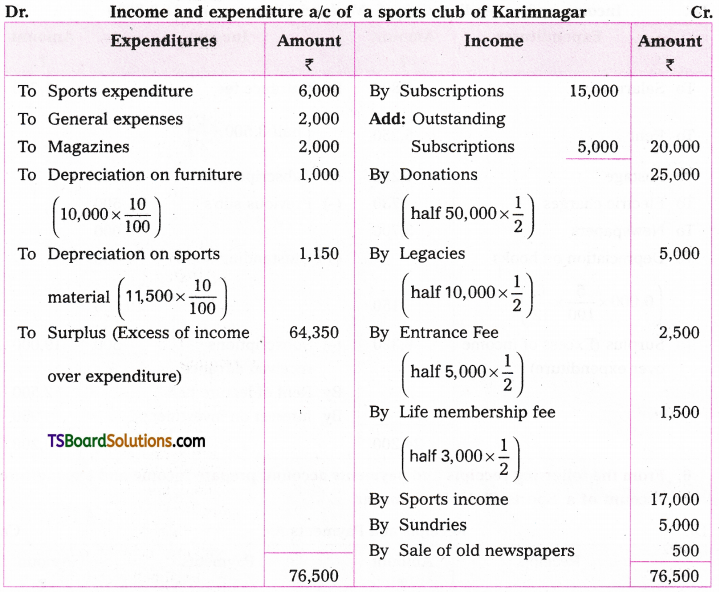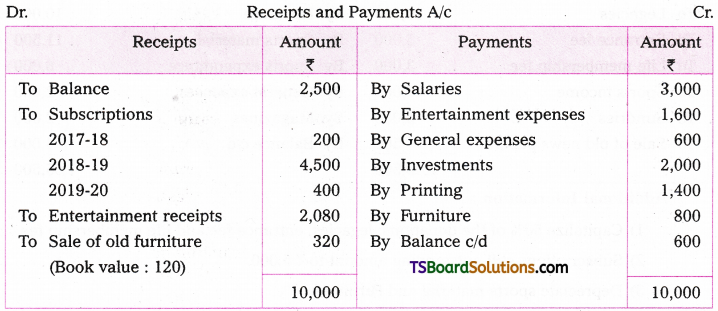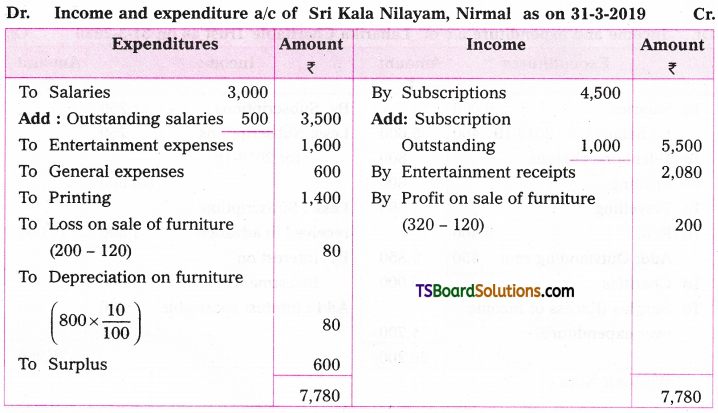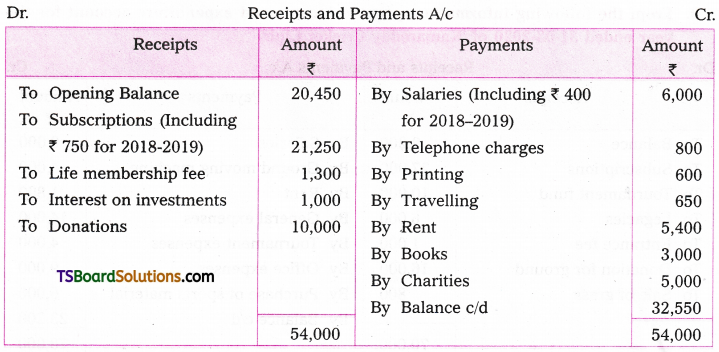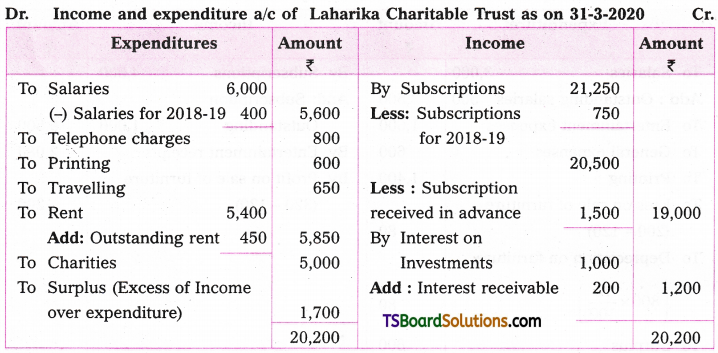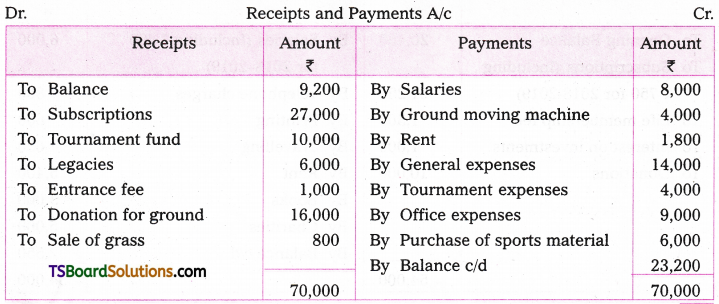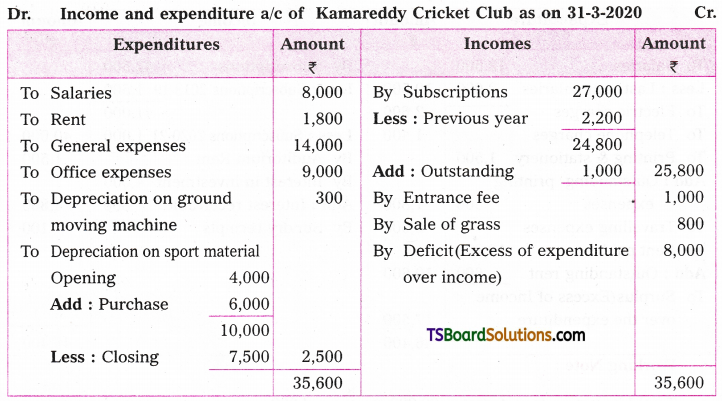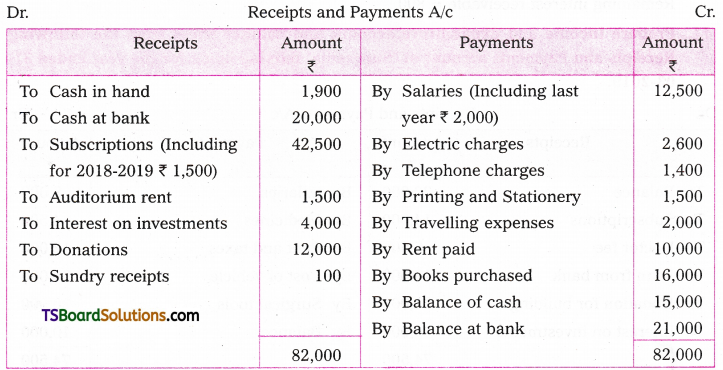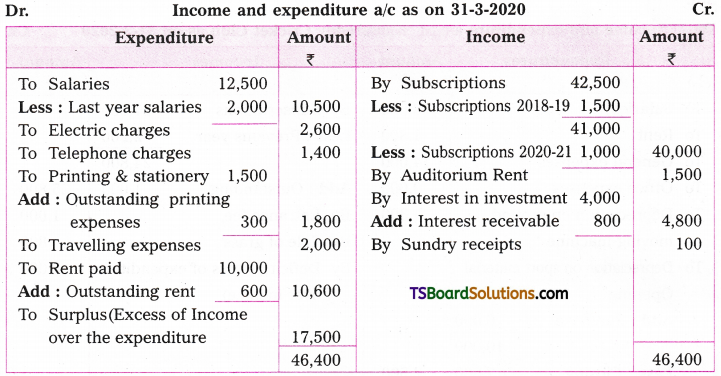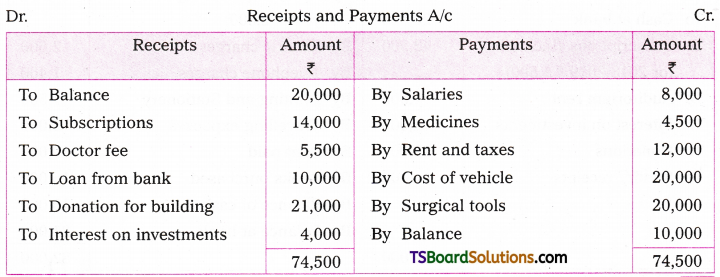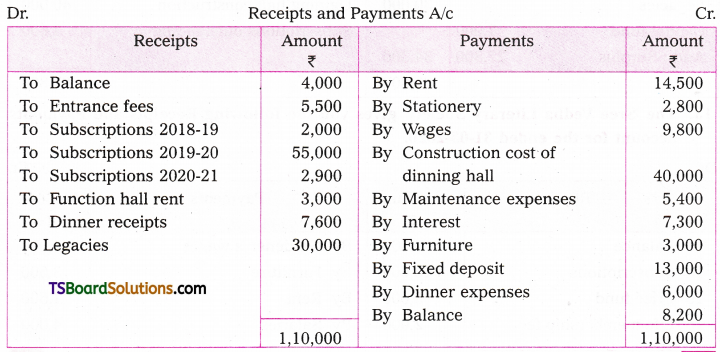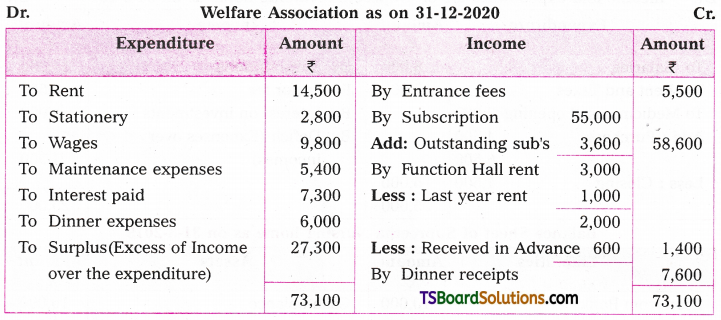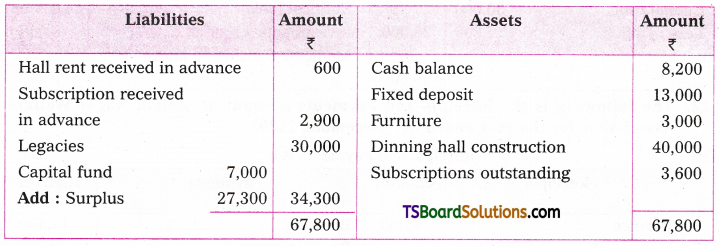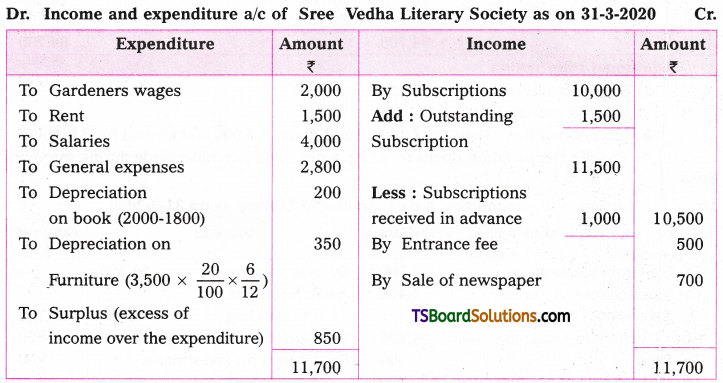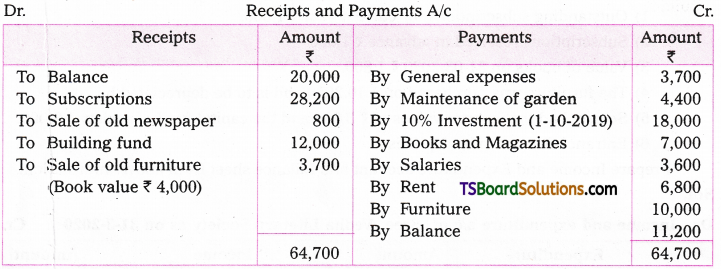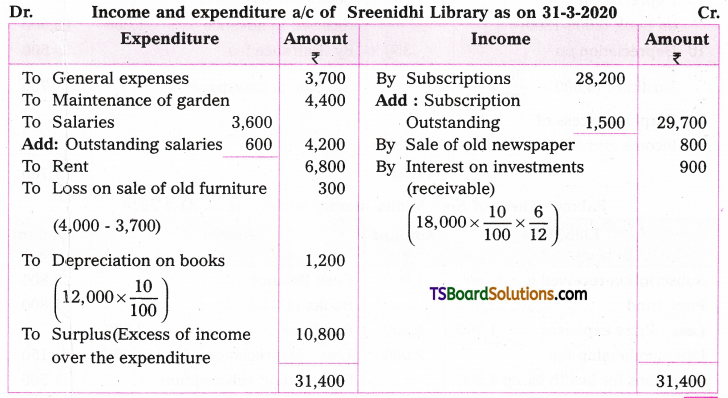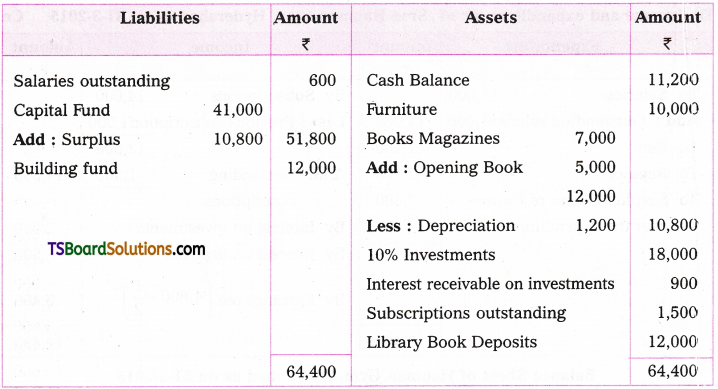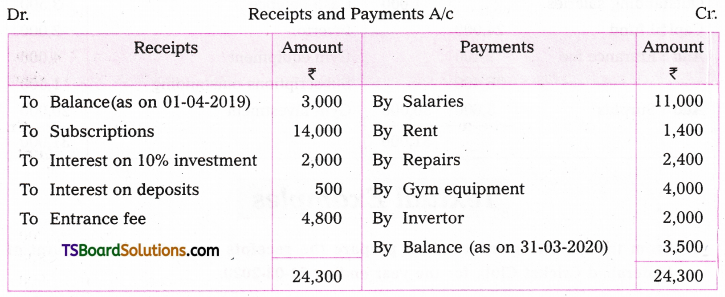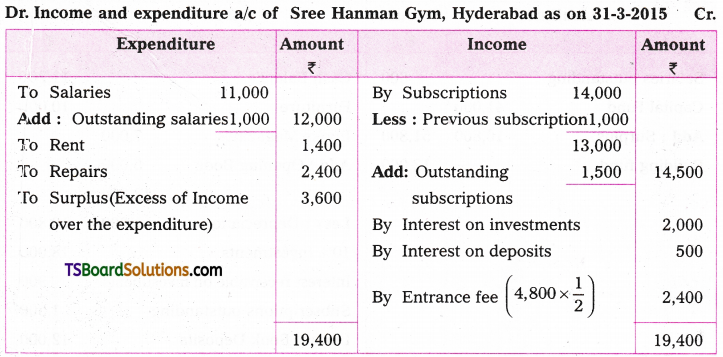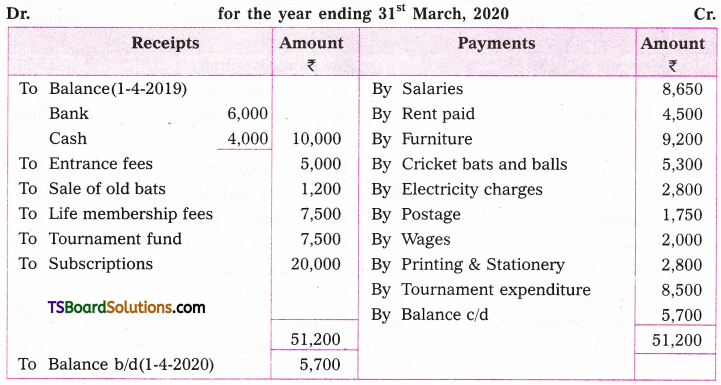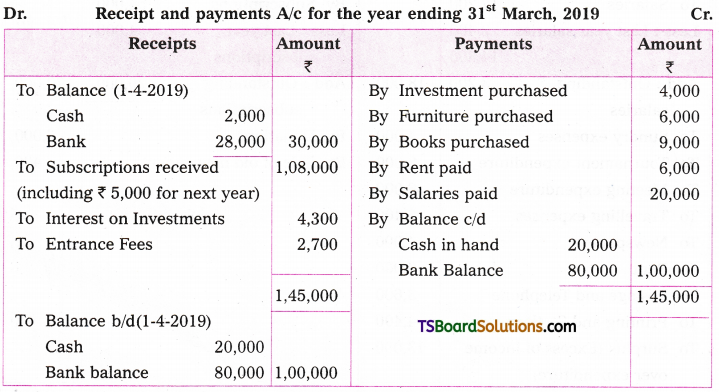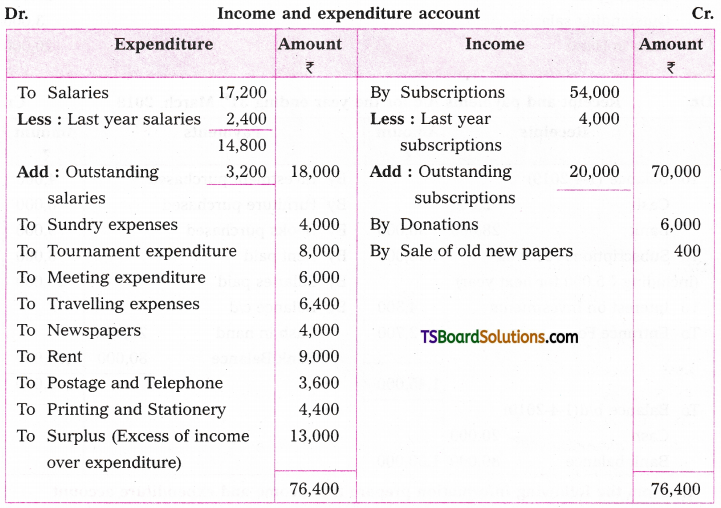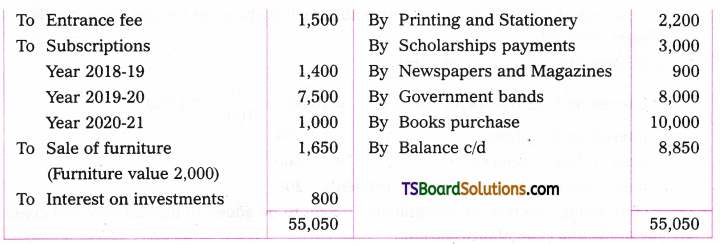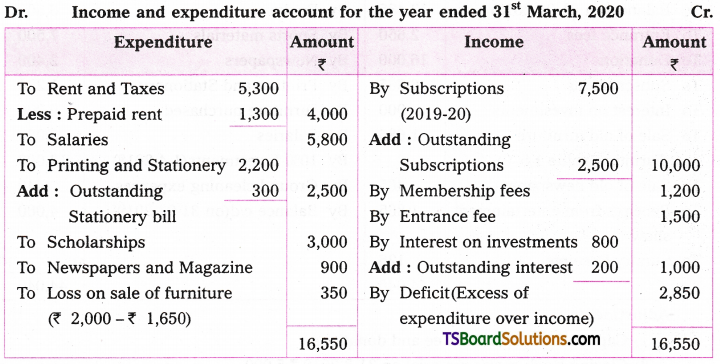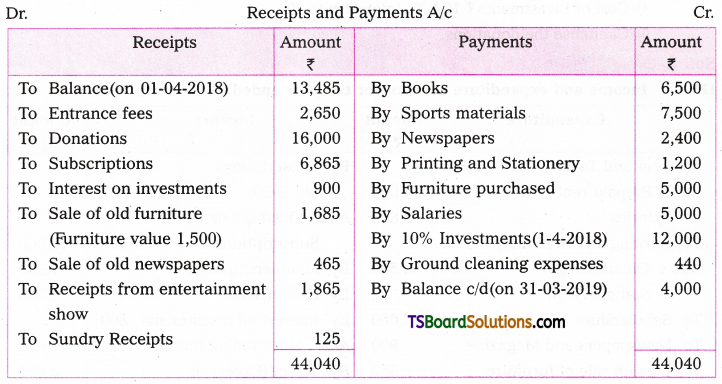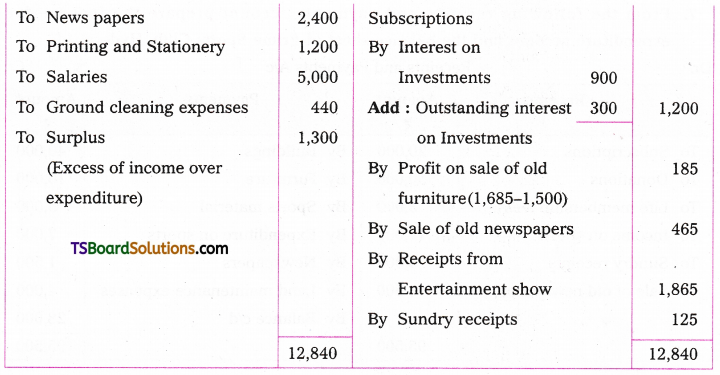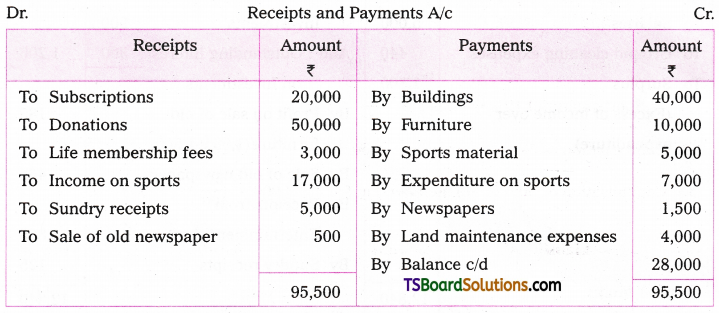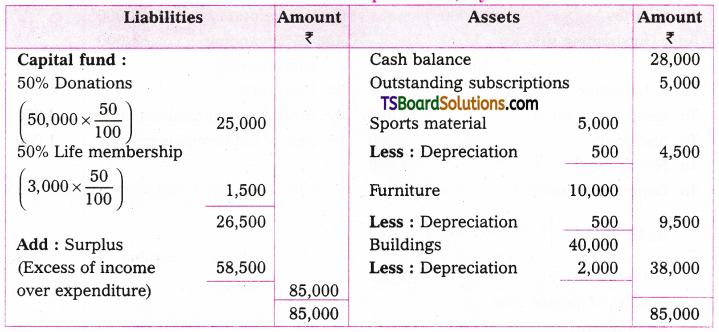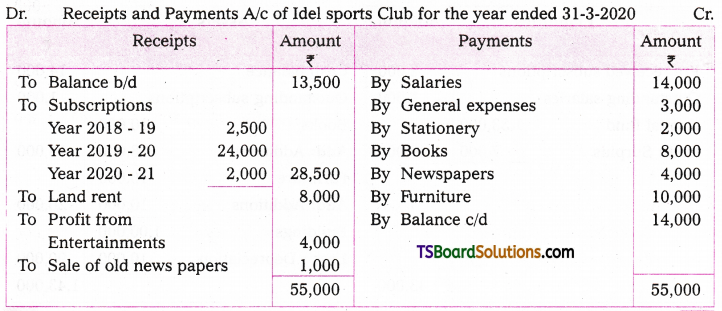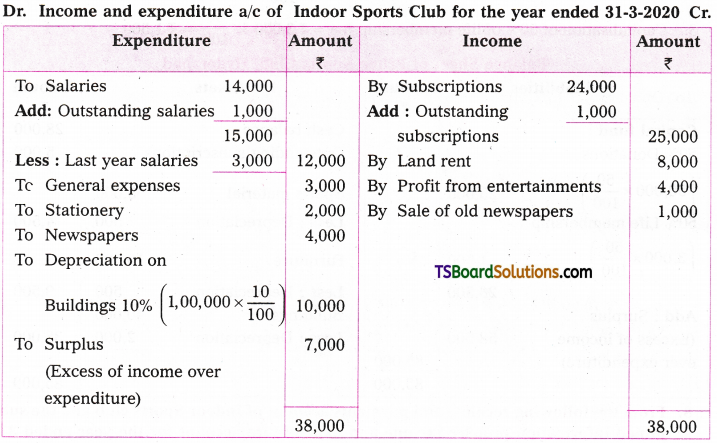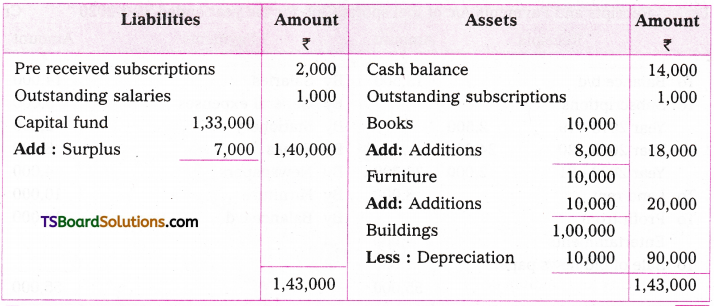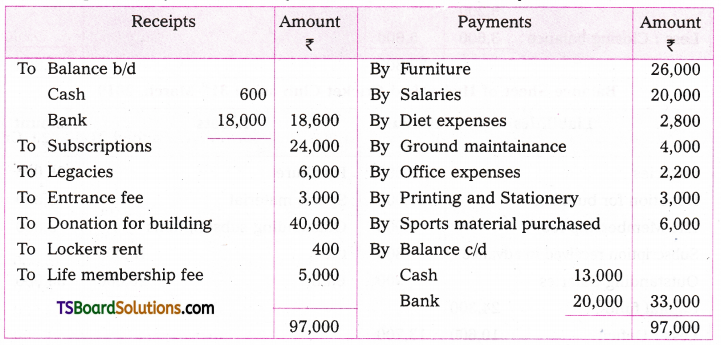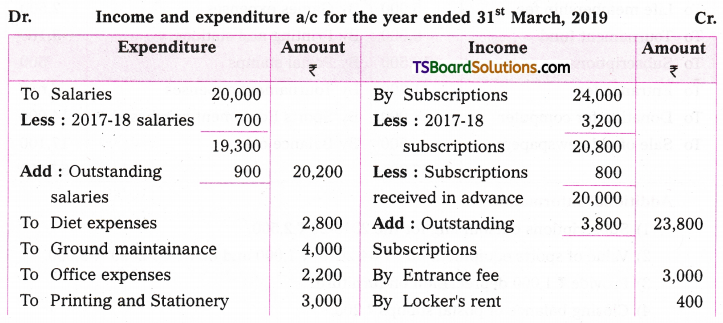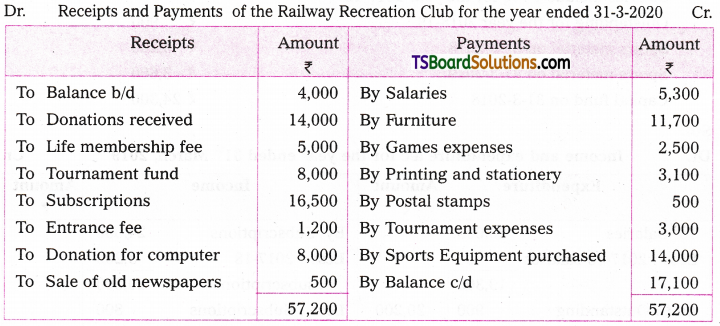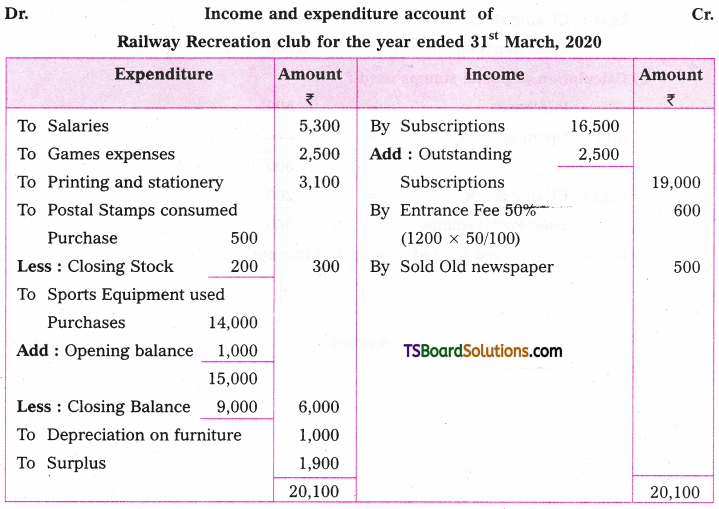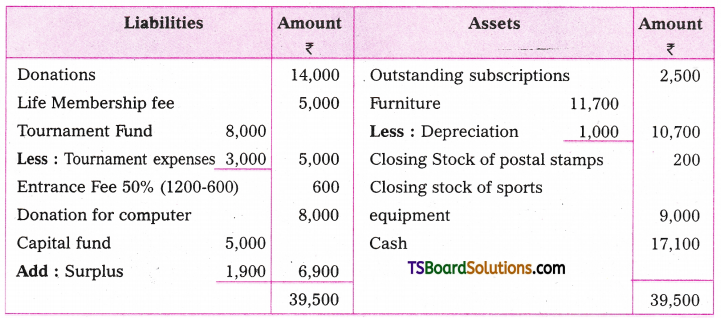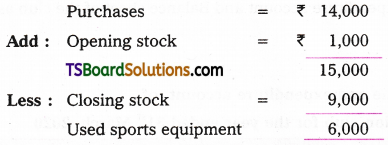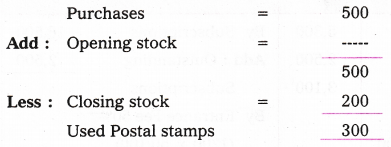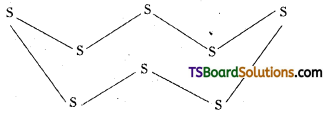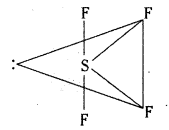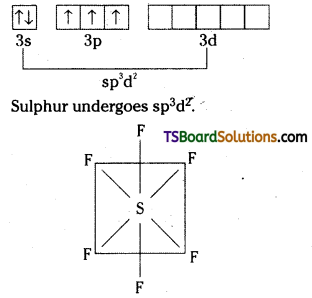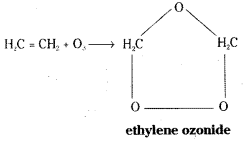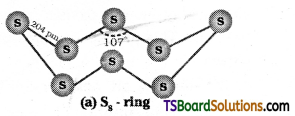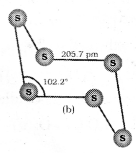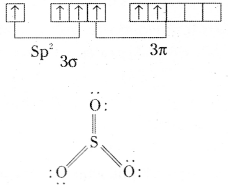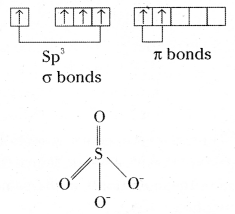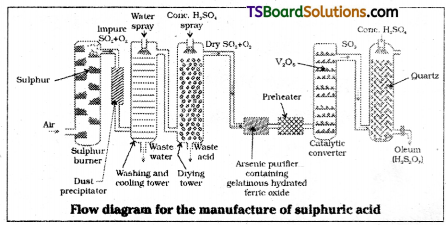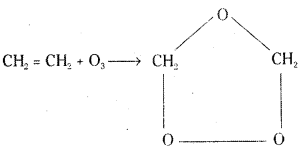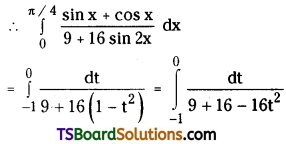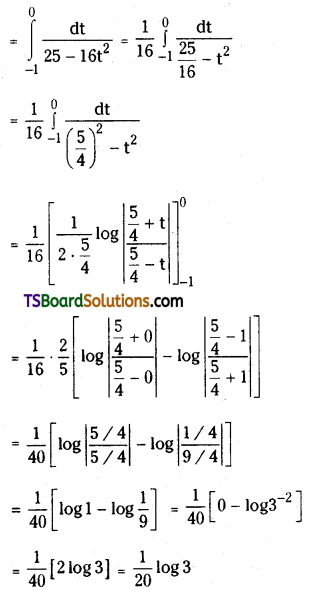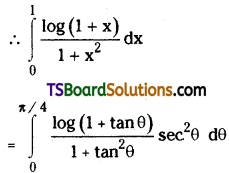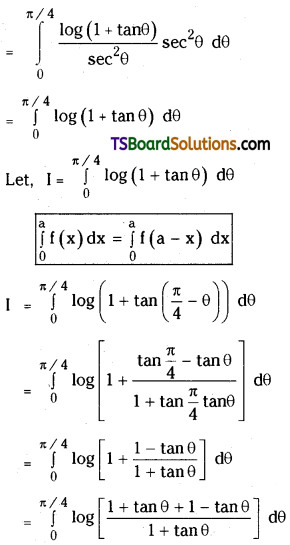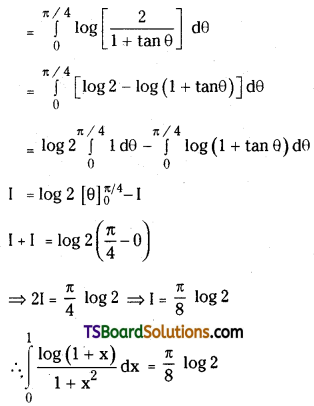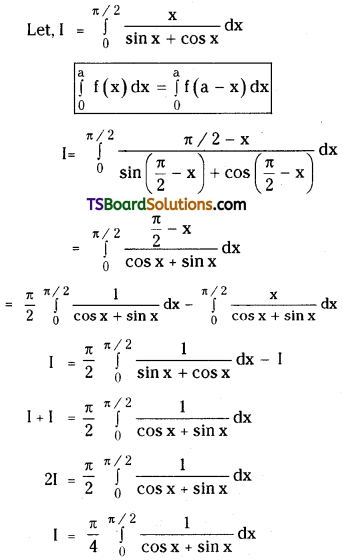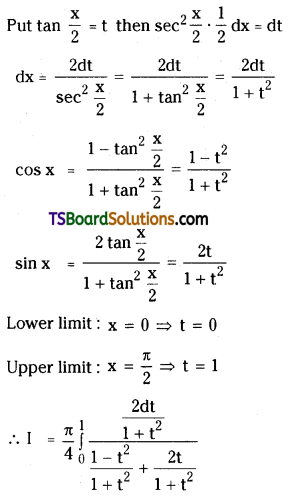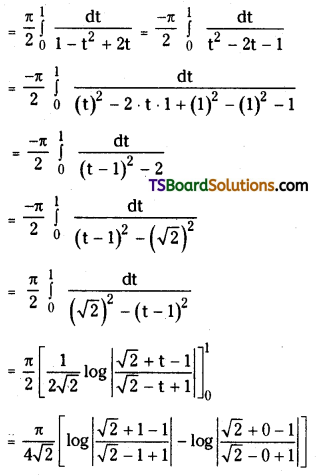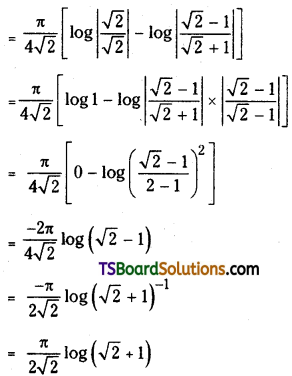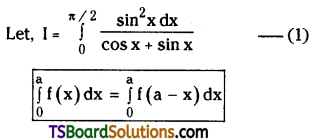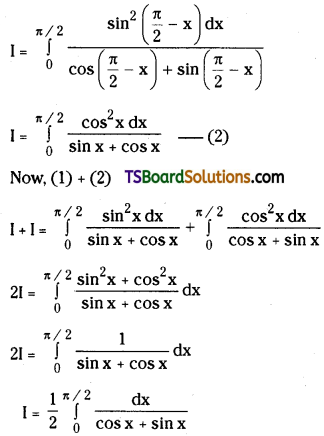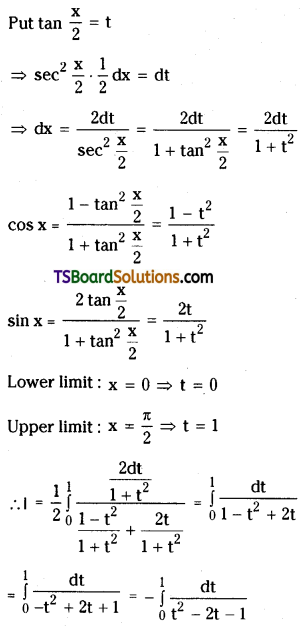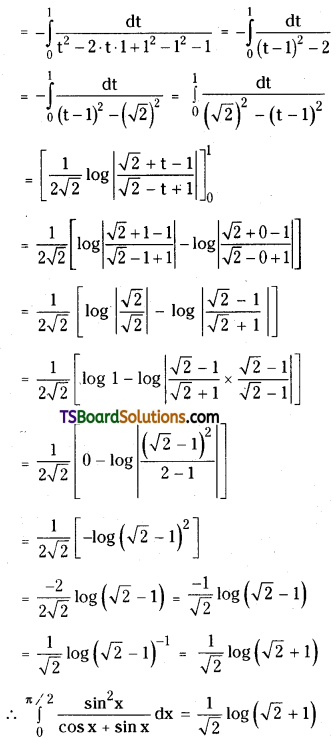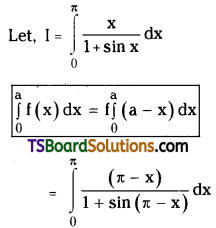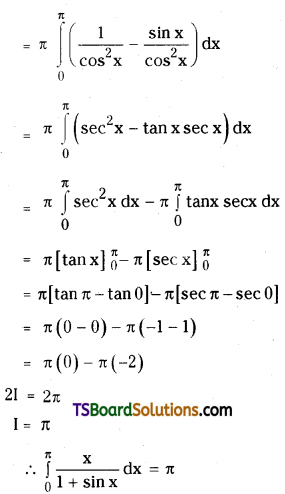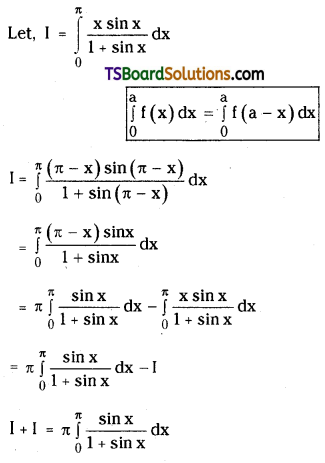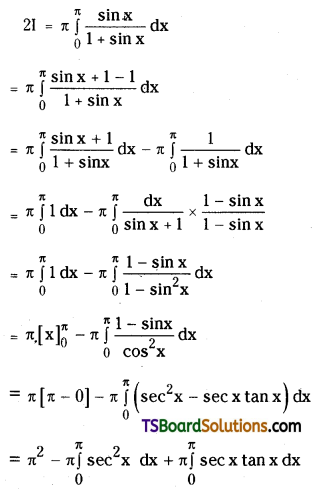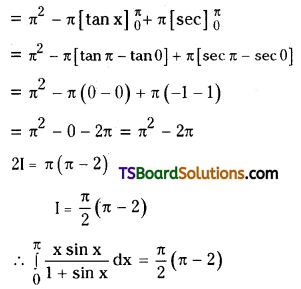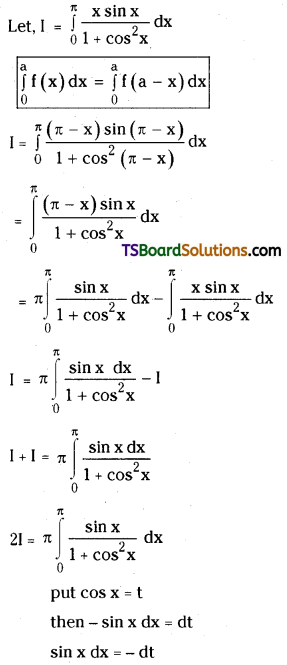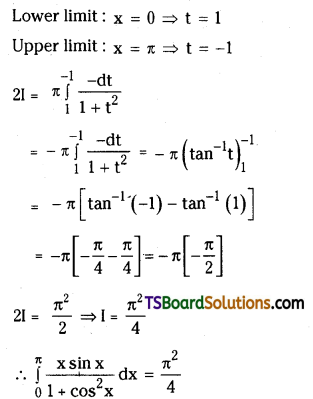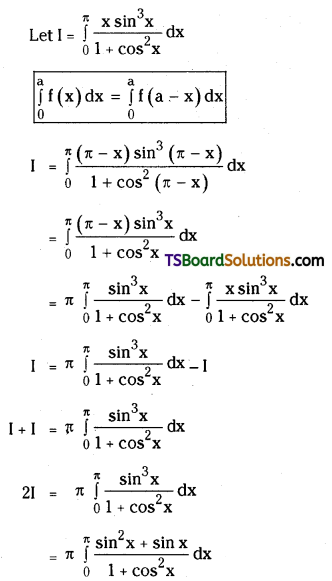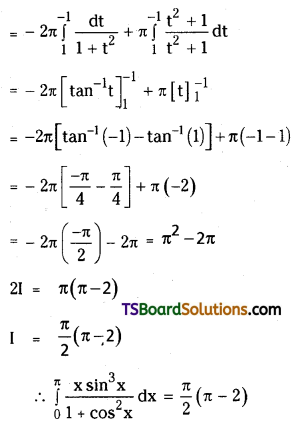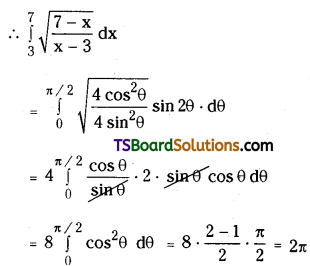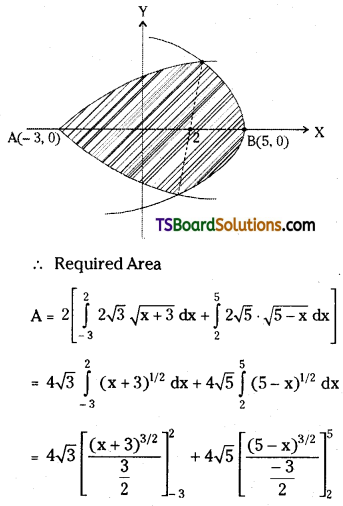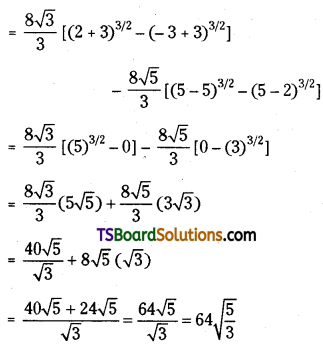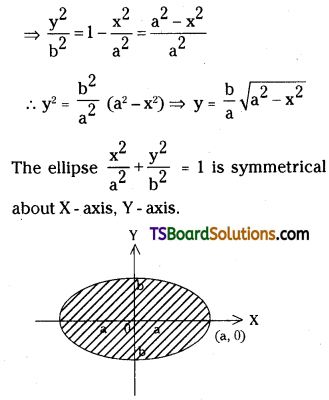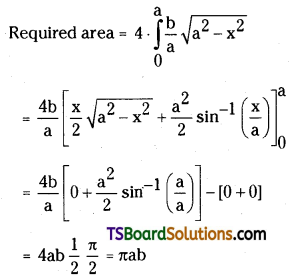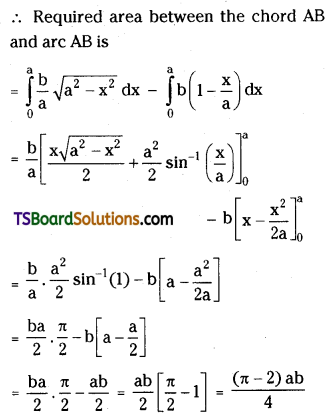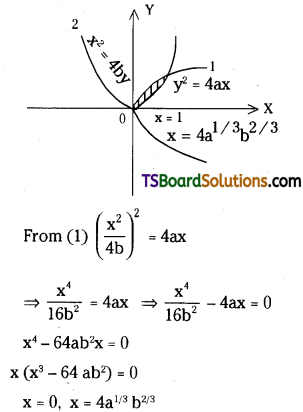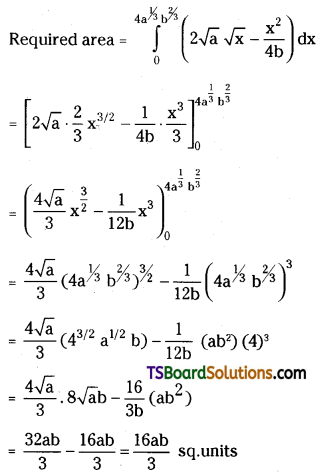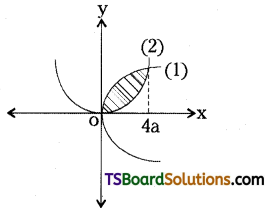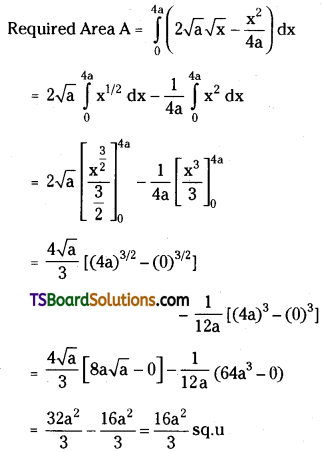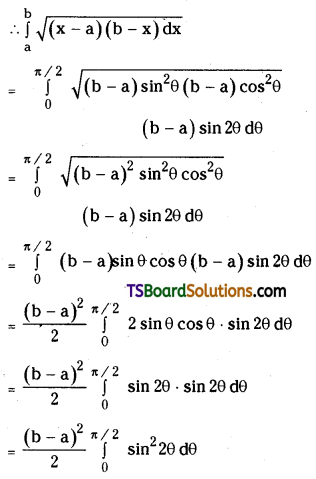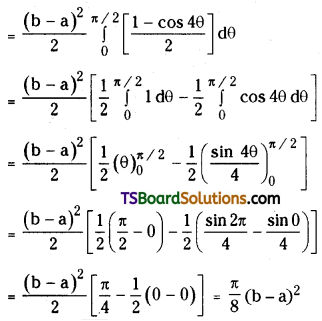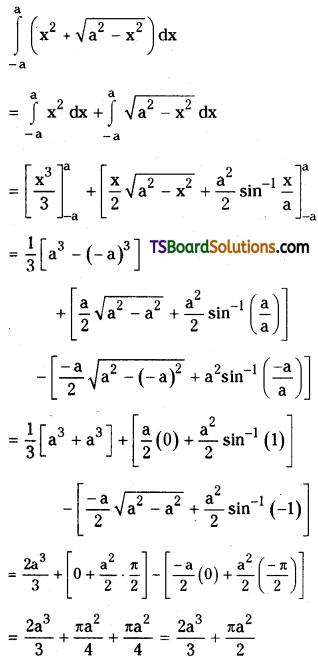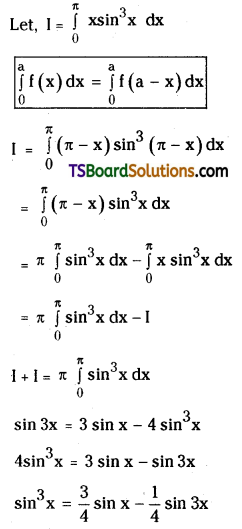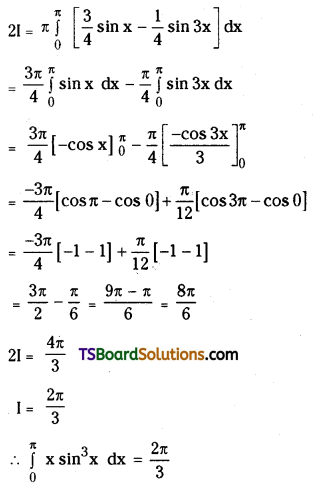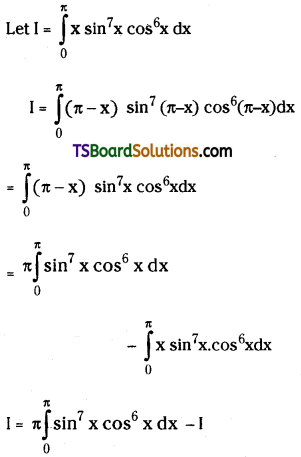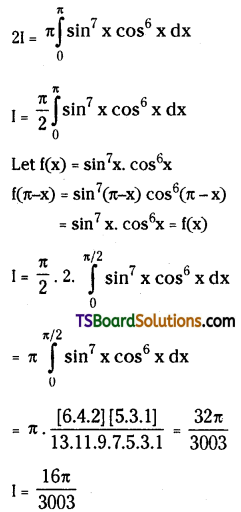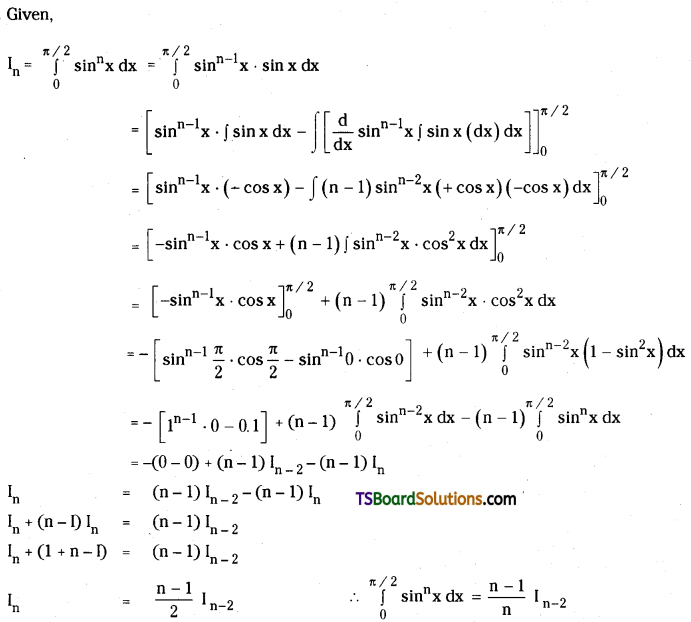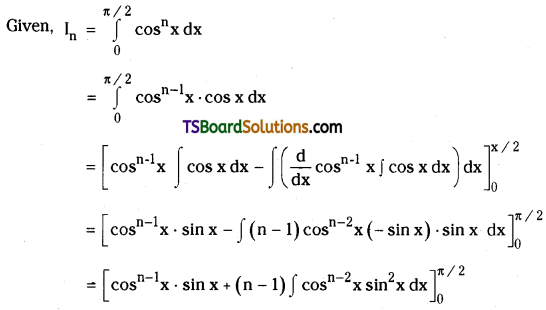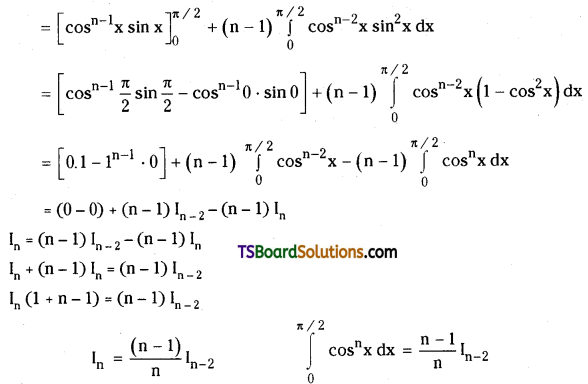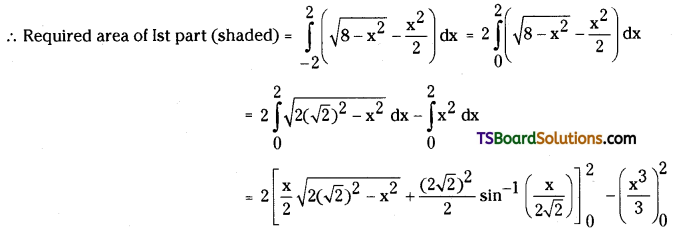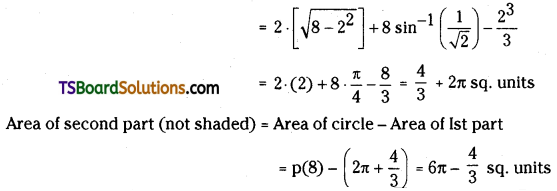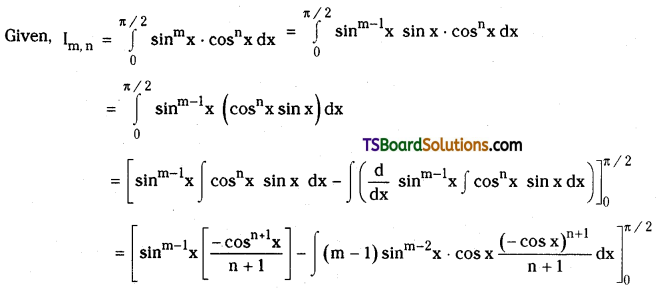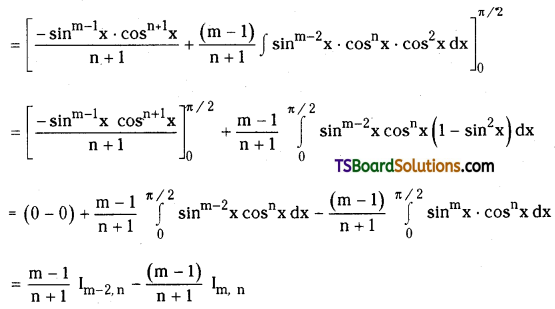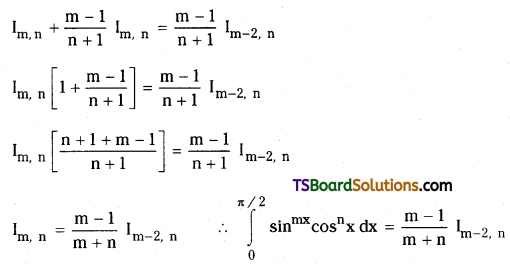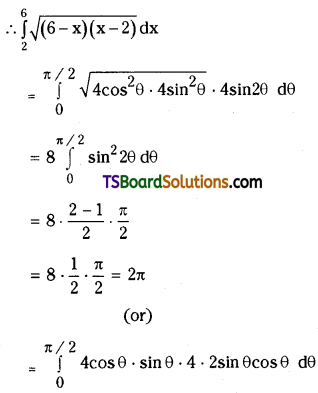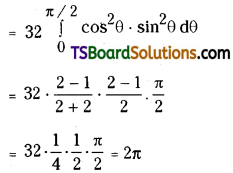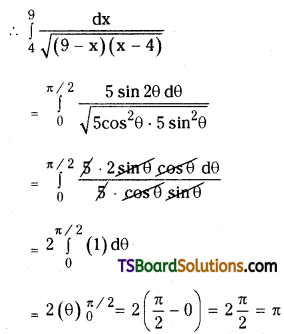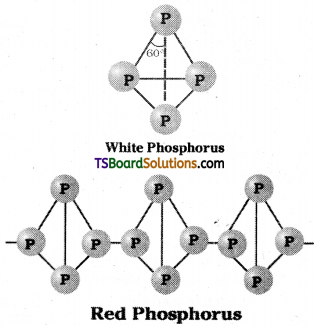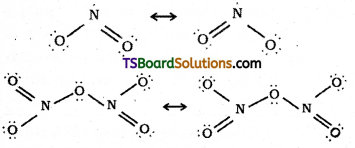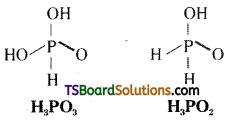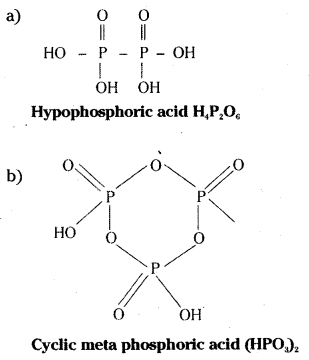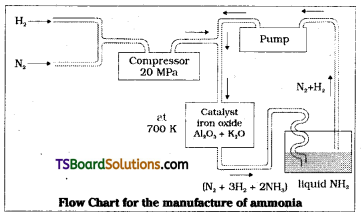Telangana TSBIE TS Inter 2nd Year Chemistry Study Material 4th Lesson Surface Chemistry Textbook Questions and Answers.
TS Inter 2nd Year Chemistry Study Material 4th Lesson Surface Chemistry
Very Short Answer Questions (2 Marks)
Question 1.
What is an interface ? Give one example.
Answer:
The boundary that separate the two bulk phases is called surface or interface, e.g. Solid-liquid or solid/liquid.
Question 2.
What is adsorption ? Give one example.
Answer:
Accumulation of molecular species at the surface rather than in bulk of a solid or liquid is known as adsorption.
Eg : Aqueous solution of raw sugar when passed over animal charcoal becomes colourless due to the removal of colouring matter of sugar by adsorption on animal charcoal.
Question 3.
What is absorption? Give one example.
Answer:
Absorption is a process of distribution of the molecules of a substance uniformly in the bulk of another substance e.g: when a sponge or chalk piece is dipped in water, water is distributed throughout the sponge or chalk piece.
![]()
Question 4.
Distinguish between adsorption and absorption. Give one example.
Answer:
| Adsorption | Absorption |
| 1. It involves unequal distribution of molecular species in bulk and at the surface. | 1. It involves uniform distribution of the molecular species throughout the bulk. |
| 2. It is rapid in the beginning and slows down near the equilibrium. | 2. It occurs at a uniform rate. |
| 3. It is a surface phenomenon. | 3. It occurs throughout the body of material. |
Eg : when a chalk piece is dipped in ink the colouring matter is retained only on the surface due to adsorption while the solvent of the ink goes deeper into the stick.
Question 5.
The moist air becomes dry in the presence of silica gel. Give reason for this.
Answer:
The moist air becomes dry in the presence of silica gel because water molecules get adsorbed on the surface of silica gel.
Question 6.
Methylene blue solution when shaken with animal charcoal gives a colourless filtrate on filtration. Give the reason.
Answer:
When animal charcoal is added to a solu¬tion of methylene blue solution and shaken the molecules of methylene blue are adsorbed on the surface of animal charcoal and are removed from solution. So the filtrate becomes colourless.
Question 7.
A small amount of silica gel and a small amount of anhydrous calcium chloride are placed separately in two corners of a vessel containing water vapour. What phenomena will occur ?
Answer:
Water vapour is absorbed by anhydrous calcium chloride but it is adsorbed on silica gel.
![]()
Question 8.
What is desorption ?
Answer:
The process of removal of an adsorbed substance from the surface is called desorption.
Question 9.
What is sorption ?
Answer:
If adsorption and absorption takes place simultaneously it is known as sorption.
Question 10.
Amongst adsorption, absorption which is a surface phenomena and why ?
Answer:
Adsorption is surface phenomenon. In this process molecular species accumulates at the surface rather than in the bulk.
Question 11.
What is the name given to the phenomenon when both adsorption and absorption take place together ?
Answer:
The name sorption is given to the phenomenon when both adsorption and absorption take place together.
![]()
Question 12.
Chalk stick dipped in an ink solution exhibits the following.
a) The surface of the stick retains the colour of the ink.
b) Breaking the chalk stick, it is found still white from inside.
Explain the above observations.
Answer:
a) The colouring matter is retained only on the surface due to adsorption. So the surface of the stick retains the colour.
b) Only the solvent of the ink goes deeper into the stick but not colouring matter. So it is still white inside.
Question 13.
What are the factors which influence the adsorption of a gas on a solid ?
Answer:
- Nature of the gas
- Nature of the adsorbent
- Specific area of the solid
- Pressure of the gas
- Temperature
- Activation of adsorbent
Question 14.
Why is adsorption always exothermic ?
Answer:
During adsorption there is always a decrease in residual forces of the surface i.e., there is decrease in surface energy which appears as heat. So adsorption is always exothermic.
Question 15.
Give the signs of AH and AS when ammonia gas gets adsorbed on charcoal.
Answer:
When ammonia gas is adsorbed on charcoal heat is liberated. So AH of adsorption is always negative (∆H = -Ve). When ammonia gas is adsorbed on charcoal the freedom of its molecules become restricted. So entropy decreases (∆S = -Ve).
![]()
Question 16.
How many types of adsorption are known? What are they?
Answer:
There are mainly two types of adsorption.
a) Physical adsorption or physisorption.
b) Chemical adsorption or chemisorption.
Question 17.
What types of forces are involved in physisorption of a gas on solid ?
Answer:
Only weak van der Waal’s forces are involved in physisorption of a gas on solid.
Question 18.
What type of interaction occuring between gas molecules and a solid surface is responsible for chemisorption of the gas on solid?
Answer:
Chemical bonds occur between gas molecules and a solid surface during chemisorption of the gas on solid. The chemical bonds may be ionic or covalent in nature.
Question 19.
Why chemisorption is called activated adsorption ?
Answer:
The chemical adsorption involves a high energy of activation. So it is called activated adsorption.
Question 20.
What is the difference between physisorption and chemisorption ?
Answer:
Physisorption is due to weak van der Waal’s forces between the gas molecules and the solid surface. Chemisorption is due to chemical bonds such as covalent or ionic between gas molecules and solid surface.
![]()
Question 21.
Out of physisorption and chemisorption, which can be reversed ?
Answer:
Physisorption can be reversed. By increasing the pressure more gas is adsorbed and by decreasing the pressure the adsorbed gas is removed. By decreasing the temperature more gas is adsorbed while by increasing the temperature the adsorbed gas is removed.
Question 22.
How is adsorption of a gas related to its critical temperature ? ,
Answer:
Easily liquefiable gases which have high critical temperatures are readily adsorbed since the van der Waal’s forces are stronger near the critical temperatures.
Question 23.
The critical temperature of SO2 is 630K and that of CH4 is 190K. Which one is adsorbed easily on actived charcoal ?
Answer:
Activated charcoal adsorbs more SO2 since it has more critical temperature than methane.
Question 24.
Easily liquifiable gases are readily adsorbed on solids. Why ?
Answer:
Easily liquifiable gases are readily adsorbed on solids because van der Waal’s forces are stronger near the critical temperature.
Question 25.
Amongst SO2, H2 which will be adsorbed more readily on the surface of charcoal and why ?
Answer:
SO2 is adsorbed more readily on the surface of charcoal compared to H2 because its critical temperature is more, as van der Waal’s forces are stronger near critical temperature.
![]()
Question 26.
Compare the enthalpy of adsorption for physisorption and chemisorption.
Answer:
The enthalpy of adsorption is low in physisorption (20 – 40 kJ mol-1) but in chemisorption it is high (80 – 240 kJ mol-1).
Question 27.
What is the magnitude of enthalpy of physical adsorption ? Give reason for this magnitude.
Answer:
The magnitude of enthalpy of physical adsorption is low i.e., about 20 -40 kJ mol-1. This is because the attraction between gas molecules and solid surface is only due to weak van der Waal’s forces.
Question 28.
What is the magnitude of enthalpy of chemisorption ? Give reason for this magnitude.
Answer:
The enthalpy of chemisorption is high 80 – 240 KJ mol-1 as it involves chemical bond formation.
Question 29.
Give any two applications of adsorption.
Answer:
- Gas masks containing activated charcoal or mixture of adsorbents used by coal miners adsorb poisonous gases during breathing.
- Due to the difference in degree of adsorption of gases by charcoal a mixture of noble gases can be separated by adsorption on coconut charcoal at different temperatures.
Question 30.
Why physisorption suffers from lack of specificity ?
Answer:
Since van der Waal’s forces are universal, a given surface of an adsorbent does not show any preference for a particular gas. So physisorption suffers from lack of specificity.
![]()
Question 31.
What is an adsorption isotherm ? Write the equation of Freundlich adsorption isotherm.
Answer:
The variation in the amount of gas adsorbed by the adsorbent with pressure at constant temperature can be shown as a curve termed as adsorption isotherm.
Freundlich adsorption isotherm is
\(\frac{\mathrm{x}}{\mathrm{m}}\) = k . p1/n (n > 1) m
where x is the mass of the gas adsorbed on mass ‘m’ of the adsorbent at pressure p. k and n are constants.
Question 32.
In the Freundlich adsorption isotherm mention the conditions under which following graph will be true ?
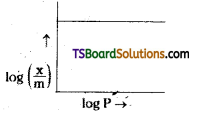
Answer:
When \(\frac{\mathrm{1}}{\mathrm{n}}\) = 0 in Freundlich adsorption isontherm, \(\frac{\mathrm{x}}{\mathrm{m}}\) = constant, the adsorption is m independent of pressure.
Question 33.
What role does adsorption play in heterogeneous catalysis ?
Answer:
Adsorption of reactants on solid surface of the catalysts increase the rate of reaction. There are many gaseous reactions of industrial importance involving use of solid catalysts.
Question 34.
What is the role of MnO2 in the preparation of O2 from KClO3 ?
Answer:
In the preparation of O2 from KClO3, MnO2 acts as catalyst and the decomposition of KClO3 takes place at considerably low temperatures.
Question 35.
Define “promoters” and “poisons” in the phenomenon of catalysis ?
Answer:
Promoters are the substances that enhances the activity of catalyst. Poisons are the substances which decrease the catalytic activity of a catalyst.
![]()
Question 36.
What is homogeneous catalysis ? How is different from heterogeneous catalysis ?
Answer:
If the reactants and the catalysts are in the same phase, the process is said to be homogeneous catalysis. In heterogeneous catalysis the reactants and catalysts are in different phases.
Question 37.
Give two examples for homogeneous catalytic reactions.
Answer:
1) Oxidation of SO2 to SO3 with O2 in the presence of oxides of N2 as catalyst in the lead chamber process.
2SO2(g) + O2 (g) ![]() > SO3 (g)
> SO3 (g)
Reactants and catalysts are gases
2) Acid catalysed hydrolysis of ester
CH3 COOC2H5(l) + H2O ![]() CH3COOH(aq) + C2H5 – OH(aq)
CH3COOH(aq) + C2H5 – OH(aq)
Reactants and catalysts are liquids
Question 38.
Give two examples for heterogeneous catalysis.
Answer:
1) Oxidation of sulphur dioxide into sulphur trioxide in the presence of Pt
2 SO2(g) + O2(g) ![]() 2SO3
2SO3
Reactants are gases while the catalyst Pt is solid.
2) Manufacture of ammonia by Haber’s process involves the combination of N2 and H2 in the presence of iron powder.
N2(g) + 3H2(g) ![]() 2NH3 (g)
2NH3 (g)
Reactants are gases catalyst is solid.
![]()
Question 39.
Give two examples which indicate the selectivity of heterogeneous catalysis.
Answer:
Selectivity of a catalyst is its ability to direct a reaction to from specific products.

Question 40.
Why zeolites are treated as shape selective catalysts ?
Answer:
Zeolites are good shape selective catalysts because of their honeycomb like structures.
The reactions taking place in zeolites depend upon the size and shape of reactant and product molecules as well as upon the pores and cavities of the zeolites.
Question 41.
Which zeolite catalyst is used to convert alcohols directly into gasoline ?
Answer:
ZSM-5 converts alcohols directly into gasoline (petrol) by dehydrating them to give a mixture of hydrocarbons.
Question 42.
What are enzymes ?What is their role in human body ?
Answer:
Enzymes are biochemical catalysts and the phenomenon of catalysis is called biochemical catalysis. These are complex nitrogenous organic compounds. They are protein molecules of higher molecular mass and form collidal solutions in water. Enzymes catalyse the life process in human body.
![]()
Question 43.
Can catalyst increase the yield of reaction?
Answer:
No. A catalyst will increase the rates of forward and backward reactions equally. So the yield of reaction do not change.
Question 44.
Name any two enzyme catalysed reactions. Give the reasons.
Answer:
i) Inversion of sugar: The enzyme invertase converts cane sugar into glucose and fructose.

ii) Conversion of glucose into ethyl alcohol:
The enzyme zymase converts glucose into ethyl alcohol and carbon dioxide.

Question 45.
Name the enzymes obtained from soya-beans source.
Answer:
Urease which converts urea into ammonia and carbon dioxide.
Question 46.
Name the used in
a) Decomposition of urea into ammonia.
b) Conversion of proteins into peptides in stomach.
Answer:
a) Decomposition of urea of into ammonia is catalysed by urease.
NH2CONH2 (aq) → 2NH3(g) + CO2(g)
b) Pepsin converts proteins into peptides in stomach.
![]()
Question 47.
What enzymes are obtained from yeast ?
Answer:
- Invertase which converts sugar into glucose and fructose,
- Zymase which converts glucose into ethyl alcohol and carbondioxide.
Question 48.
At what ranges of temperature and pH, enzymes are active ?
Answer:
The optimum temperature range for enzymatic activity is 298 – 310K.
The pH range for enzymatic activity is 5-7.
Question 49.
Represent diagramatically the mechanism of enzyme catalysis.
Answer:
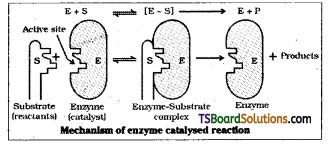
Question 50.
Name any two industrially important heterogeneous catalytic reactions mentioning the catalysts used.
Answer:
- In Haber’s process for the manufacture of ammonia, catalyst is iron powder mixed with molybdenum as promoter.
- In Contact process for the manufacture of sulphuric acid, catalyst is platinised asbestos or vanadium pentoxide.
Question 51.
What is a colloidal solution ? How is it different from a true solution with respect to dispersed particle size and homogeneity ?
Answer:
A colloidal solution is a heterogeneous sys-tem in which one substance is dispersed (dispersed phase) as large particles in another substance (dispersion medium) Colloidal particles are larger than simple molecules of a true solution. Their size range between 1 and 1000 nm (10-9 to 10-6m).
![]()
Question 52.
Name the dispersed phase and dispersion medium in the following colloidal system i) fog ii) smoke iii) milk.
Answer:
- Fog : Dispersed phase : Liquid
Dispersed medium : Gas - Smoke : Dispersed phase : Solid
Dispersed medium : Gas - Milk : Dispersed phase : Fat
Dispersed medium : Water
Question 53.
What are lyophilic and lyophobic sols ? Give one example for each type.
Answer:
Colloids in which there is affinity between dispersed phase and dispersion medium are called lyophilic sols.
Ex : Starch sol, Gelatin. ,
Colloids in which there is very little affinity between the dispersion medium, and dispersed phase are called lyophobic sols.
Ex : Smoke, Gold sol.
Question 54.
Explain the terms with suitable examples.
i) aerosol
ii) hydrosol
Answer:
i) Aerosol is a colloidal system in which dispersed phase is liquid and dispersion medium is gas. e.g : fog, smoke.
ii) Hydrosol is the colloidal system that consists of water as dispersion medium. e.g : Starch in water, milk.
Question 55.
Explain why lyophilic colloids are relatively more stable than lyophobic colloids.
Answer:
Lyophilic colloids are more stable than lyophobic colloids because lyophilic colloids are extensively solvated. The colloidal particles are covered by a sheath of the dispersion medium in which they are dispersed.
Question 56.
Give two examples of colloidal solutions of liquids dispersed in solid. What is the name given to colloidal solution ?
Answer:
- Butter
- Cheese
Liquids dispersed in solid type colloids are named as gels.
![]()
Question 57.
What is the difference between multimolecular and macromolecular colloids ? Give one example for each.
Answer:
In multimolecular colloids large number of atoms or small molecules of the dispersed phase aggregate together to form species in the colloidal range. e.g.: Gold sol, sulphur sol.
In macromolecular colloids the size of individual macromolecules are in the colloidal range.
e.g.: Starch, proteins etc.
Question 58.
What are micelles ? Give one example.
Answer:
The substances which behave as electrolytes at low concentration but at higher concentrations exhibit colloidal behaviour due to formation of aggregates are called micelles and the colloids formed are called associated colloids. They contain a hydrophobic long hydrocarbon chain as one end and a hydrophilic polar group as another end. e.g.: Sodium stearate R COO– Na+.
Question 59.
How do micelles differ from a normal collodial solutions ?
Answer:
Micelles contain a long hydrocarbon part which is hydrophobic tail and a polar hydrophilic head. These are absent in normal colloidal solution.
eg. Sodium stearate C17H–35COO–Na+ contain long hydrocarbon part stearate radical (C17H35–) is hydrophobic tail while COO– part is hydrophilic head.
Question 60.
Give two examples of associated colloids.
Answer:
- Soaps dissolved in water
- Detergents dissolved in water.
![]()
Question 61.
Can the same substance act both as colloid and crystalloid ?
Answer:
Yes. The same substance can act both as colloid and crystalloid.
e.g.: Common salt
(NaCl) a typical crystalloid in an aqueous solution behave as a colloid in the benzene medium.
Question 62.
Give two examples of lyophobic sols.
Answer:
- Metal colloids like gold sol.
- Collids of metal sulphides such as AS2S3.
Question 63.
Give examples of colloidal system of
i) Liquid in solid
ii) gas in solid.
Answer:
i) Example for liquid in solid is cheese or butter.
ii) Example for gas in liquid is froth or soap lather.
Question 64.
What type of substances form lyophobic sols?
Answer:
Substances like metals, and their sulphides form lyophobic sols.
Question 65.
What is Critical Micelle Concentration (CMC) and Kraft temperature ?
Answer:
The formation of micelle takes place above certain temperature called Kraft temperature and above a particular concentration called Critical Micelle Concentration.
![]()
Question 66.
Why lyophobic colloids are called irreversible colloids ?
Answer:
Lyophobic sols are readily precipitated on the addition of small amounts of electrolytes or by heating or by shaking. The precipitates does not give back the collodial sol by simple addition of the dispersion medium to it. So they are called irreversible colloids.
Question 67.
How a colloidal sol of arsenous sulphide is prepared ?
Answer:
Arsenous sulphide sol can be prepared by ; double decomposition method of arsenous i oxide and hydrogen sulphide.
AS2O3 + 3H2 S → AS2S3 (sol) + 3H2O
Question 68.
What is peptization ?
Answer:
Peptization is a process of converting a precipitate into colloidal sol by shaking it with the dispersion medium in the presence of a small amount of electrolyte. The electrolyte used for this purpose is called peptizing agent.
Question 69.
What is dialysis ? How is dialysis can be made feat ?
Answer:
Dialysis is a process of removing of dissolved substance from a collodial solution using a suitable membrane. Dialysis can be made fast by applying emf if the dissolved substance in impure colloidal solution is an electrolyte i.e., electrodialysis.
Question 70.
What is collodion solution ?
Answer:
Collodion is a 4% solution of nitro – cellulose in a mixture of alcohol and ether.
![]()
Question 71.
How an ultrafilter paper is prepared from ordinary filter paper ?
Answer:
Ultra filter paper is prepared by soaking the filter paper in collodion solution hardening by formaldehyde and then finally drying it.
Question 72.
What is Tyndall effect ?
Answer:
Colloidal particles scatter light in all directions in space. The scattering of light illuminates the path of beam in the colloidal dispersion. This is known as Tyndall effect.
Question 73.
Under what conditions is Tyndall effect observed ?
Answer:
Tyndall effect is observed only when the following two conditions are satisfied.
- The diameter of the dispersed particles is not much smaller than the wavelength of the light used.
- The refractive indices of the dispersed phase and the dispersion medium differ greatly in magnitude.
Question 74.
Can Tyndall effect be used to distinguish between a collodial solution and a true solution ? Explain.
Answer:
Tyndall effect is used to distinguish between a colloidal solution and a true solution. When an intense beam of light is focussed on the collodial solution contained in a glass vessel, the focus of light can be observed with a microscope kept at right angles to the beam. Individual colloidal particles appear as bright stars.
![]()
Question 75.
Sky appears blue in colour. Explain.
Answer:
Dust particles along with water vapour suspended in air, scatter blue light which reaches our eyes and hence the sky looks blue.
Question 76.
What is Brojvnian movement ?
Answer:
The zig-zag motion of colloidal particles all over the field of view in a collodial solution is called Brownian movement.
Question 77.
What is the main cause for charge on a colloidal solution ?
Answer:
Preferential adsorption of ions is the main cause for charge on a colloidal particle. The sol particles acquire positive or negative charge by preferential adsorption of positive or negative ions.
Question 78.
What is electrokinetic potenital or zeta potential ?
Answer:
The potential difference between the fixed layers and the diffused layer of opposite charge in a colloidal solution is called the electrokinetic potential or zeta potential.
Question 79.
Write the formula of positively charged and negatively charged hydrated ferric oxide collodial solutions.
Answer:
If FeCl3 solution is added to hot water a positively charged sol of hydrated ferric oxide is formed due to adsorption of Fe3+ ions. However when ferric chloride solution is added to NaOH solution taken in excess, a negatively charged sol is obtained with adsorption of OH– ions.
Fe2O3 . xH2O / Fe 3+
Positively charged
Fe2O3 . xH2O /OH–
Negatively charged
![]()
Question 80.
Give the order of coagulating power of Cl–, SO42-, PO43- in the coagulation of positive sols.
Answer:
PO43- > SO42- > Cl–
More the charge on anion more is the coagulating power.
Question 81.
Amongst Na+, Ba2+, Al3+ which coagulates negative sol readily and why ?
Answer:
According to Hardy – Schulze rule more the charge on ion more is the coagulating power of the oppositely charged colloid. Since Al carry more charge coagulates negative sol readily.
Question 82.
A colloidal solution of AgI is positively charged when prepared from a solution containing excess of Ag+ ions and negatively charged when prepared solution containing excess of I– ions. Explain.
Answer:
A collodial particle adsorb the ion from solution which is common to it. When AgI colloid is prepared from a solution containing excess Ag+ ions, the colloidal particle adsorb Ag+ ion and thus get positive charge. If Agl colloid is prepared from solution containing excess I– ions, the colloidal particle adsorb I– ions and thus get negative charge.
Question 83.
What is electrophoresis ?
Answer:
The movement of colloidal particles under an applied emf is called electrophoresis.
Question 84.
What is electro osmosis ?
Answer:
If the movement of colloidal particles is arrested by some suitable means, the dispersion medium moves in opposite direction under the applied emf. This phenomenon is called electro osmosis.
![]()
Question 85.
What is coagulation ?
Answer:
The process of settling down of colloidal particles is called coagulation or precipitation or flocculation of the sol.
Question 86.
Define flocculation value.
Answer:
The minimum concentration of an electrolyte in millimoles per litre required to cause coagulation of a sol in two hours is called flocculation value.
Question 87.
State Hardy – Schulze rule.
Answer:
Greater the valence (charge) of the coagu-lating ion added greater is its power to cause coagulation. This is known as Hardy-Schulze rule.
Question 88.
Coagulation takes place when sodium chloride solution is added to a colloidal solution of hydrated ferric oxide. Explain.
Answer:
When sodium chloride solution added to a colloidal solution of hydrated ferric oxide, the Na+ ions neutralize the negative charge on colloidal particles then colloidal particles come close, combine forming bigger particles and thus coagulated.
Question 89.
How are lyophobic solutions protected from phenomenon of coagulation ?
Answer:
Lyophobic colloids are protected from coagulation by adding lyophilic colloids to lyophobic colloid. The lyophilic colloid form a protective layer around lyophobic particles and thus protect the lyophobic colloid from the action of electrolytes.
![]()
Question 90.
What is protective colloid ?
Answer:
When lyophilic colloid is added to lyophobic colloid, the lyophilic colloid form a protective layer around lyophobic colloid and thus protect the lyophobic colloid from the action of electrolytes. So the lyophilic colloids are called protective colloids.
Question 91.
What is an emulsion ? Give two examples.
Answer:
Emulsions are liqud – liquid colloidal systems in which finely divided droplets of one liquid dispersed in another. If a mixture of two immiscible or partially miscible liquids is shaken a coarse dispersion of one liquid in the other called enjulsion is obtained.
Ex : Milk and Vanishing cream.
Question 92.
How emulsions are classified ? Give one example for each type of emulsion. [Mar. 2018 . TS]
Answer:
Emulsions are two types.
- Oil dispersed in water or oil/water (o/w) type eg. Milk, Vanishing cream.
- Water dispersed in oil (water / oil) (w/o) type. eg. Butter, cream.
Question 93.
What is an emulsifying agent ?
Answer:
For stablisation of an emulsion, the third component added to emulsion is called emulsifying agent. Eg (Proteins and soaps are emulsifying agent for o/w emulsions.
Question 94.
What is demulsification ? Name two demulsifiers.
Answer:
Separation of an emulsion into consituent liquids is called demulsification. Demulsification can be carried by heating, freezing, centrifusing etc.
![]()
Question 95.
How is artifical rain produced ?
Answer:
Artificial rain can be produced by throwing electrified sand or spraying a sol carrying charge opposite to the one on clouds from an aeroplane.
Question 96.
Bleeding from fresh cat can be stopped by applying alum. Give reasons.
Answer:
Blood is a colloidal solution of alluminoid substances. The styptic action of alum is due to coagulation of blood forming a clot which stops further bleeding.
Question 97.
Deltas are formed at the points where river enters the sea. Why ?
Answer:
River water is a colloidal solution of clay. Sea water contains a number of electrolytes. When river water meets the sea water, the electrolytes of sea water coagulates the colloidal solution of clay resulting in its deposition of clay with formation of delta.
Question 98.
Name any two applications of colloidal solutions.
Answer:
- Purification of drinking water : Water from natural sources contain collodial impurities. When alum is added the colloidal particles in water coagulates and the water becomes fit for drinking.
- Several medicines are used as colloi-dal solutions : Colloidal medicines are more effective due to their large surface area and are therefore easily assimilated.
![]()
Question 99.
How can aerial pollution by colloidal particles of smoke be prevented ? Explain.
Answer:
Smoke is a colloidal solution of solid particles such as carbon, arsenic compounds, dust etc. The smoke is made to pass through a precipitator called Cottrell precipitator. Before coming out of chimney the precipitator contain plates carrying opposite charge to that carried by smoke particles. The particles on coming in contact with these plates lose their and get precipitated.
Question 100.
Alum is used to purify water obtained from natural soruces. Explain.
Answer:
Water from natural sources contain colloidal impurities. When alum is added, the colloidal particles in water coagulates and the water becomes fit for drinking.
Question 101.
Why medicines are more effective in colloidal state ?
Answer:
Medicines in colloidal state are more effective due to their large surface area and are therefore easily assimilated.
Question 102.
How rubber is obtained from latex ?
Answer:
Plant latex is a colloidal solution of rubber particles which are negatively charged. Rubber is obtained from latex by coagulation on adding electrolytes.
![]()
Question 103.
Name the type of emulsion to which milk belongs.
Answer:
Milk is an emulsion of oil dispersed in water (o/w) type.
Short Answer Questions (4 Marks)
Question 104.
What is adsorption? Discuss the mechanism of adsorption of gases on solids.
Answer:
The accumulation of molecular species at the surface rather than in the bulk of a solid or liquid is known as adsorption.
Mechanism of adsorption :
Adsorption arises due to the fact that the surface particles of the adsorbent are not in the same environment as the particles inside the bulk. The particle inside the bulk is surrounded by other particles in all directions and all the forces acting between the particles are mutually balanced.
But the particle on the surface have no particles of its own above it and contain only below to it. So these unbalanced residual attractive forces are responsible for attracting the adsorbate molecules on its surface.
Question 105.
What are different types of adsorption ? Give any four differences between characteristics of these different types. [TS Mar. 19; (AP & TS 15)]
Answer:
Adsorption is two types, i) Physical adsor-ption and 2) Chemical adsorption.
| Physical Adsorption | Chemical Adsorption |
| 1. It is due to van der Waals’ forces. | 1) It is due to chemical bond formation. |
| 2. It is not specific in nature. | 2) It is highly specific in nature. |
| 3. It is reversible in nature. | 3) It is irreversible. |
| 4. Enthalpy of adsorption is low (20 – 40 kJ mol-1). | 4) Enthalpy of adsorption is high (80-240 kJ mol-1). |
| 5. Easily liquefiable gases adsorb easily. | 5) Gases which can react with the adsorbent show chemisorption. |
Homogeneous catalysis: When the reactants and the catalyst are in the same phase i.e., either liquid or gas the process is said to be homogeneous catalysis.
![]()
Question 106.
What do you understand by the terms given below ?
a) Absorption
b) Adsorption
c) Adsorbent and adsorbate
Answer:
a) Absorption: Uniform distribution of the substance throughout the bulk of a solid is absorption.
b) Adsorption: Accumulation of molecular species at the surface rather than in the bulk of solid or liquid is known as adsorption.
c) The substance which concentrates or accumulates on the surface is termed as adsorbate and the material on the surface of which the adsorption takes place is called adsorbent.
Question 107.
Adsorption of a gas on the surface of solid is generally accompanied by decrease in entropy. Still it is a spontaneous process. Explain.
Answer:
During adsorption there is always decrease in surface energy which appears as heat. So adsorption is always exothermic and ∆H of adsorption is always negative. But during adsorption entropy of the gas decreases due to decrease in the movement of gas molecules.
Thus entropy of adsorption AS is also negative. For the process of adsorption ∆G must be negative at a constant temperature on the basis of equation ∆G = ∆H – T∆S. In the equation ∆G = ∆H – T∆S, ∆G can be negative if ∆H has sufficiently more negative value and -T∆S is positive. The combination of these two factors makes ∆G negative. So adsorption process becomes spontaneous.
As the adsorption proceeds ∆H become less negative and becomes equal to T∆S and ∆G become zero. At this state equilibrium is attained.
Question 108.
How can the constants k and n of the Freundlich adsorption equation be calculated ?
Answer:
Freundlich adsorption isotherm is
\(\frac{\mathrm{x}}{\mathrm{m}}\) – k . p1/n (n > 1) ……………… (1)
Where x is the mass of gas adsorbed
m is the mass of adsorbent
p is the pressure
Taking logarithms of equation (1)
log \(\frac{\mathrm{x}}{\mathrm{m}}[/latex = logk + [latex]\frac{\mathrm{1}}{\mathrm{n}}[/latex log p
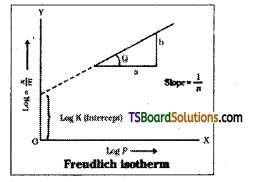
A graph is plotted by taking [latex]\frac{\mathrm{x}}{\mathrm{m}}\) on Y – axis and log p on X – axis. This gives a straight line the slope of the straight line gives the value of \(\frac{\mathrm{1}}{\mathrm{n}}\) . The intercept on the Y – axis n gives the value of log k.
Question 109.
How does the extent of adsorption depend upon
a) Increasing the surface area per unit mass of adsorbent
b) Increasing temperature of the system
c) Increasing pressure of the gas.
Answer:
a) The surface area available for adsorption per unit mass of adsorbent is known as specific area. Greater the specific area of the solid, greater would be its adsorbent power. Because of this reason porous or finely divided forms of adsorbents adsorb more extensively.
b) The adsorption at a surface initially increases till a saturation point is achieved. At this juncture an equilibrium is established.
Adsorption ⇌ Desorption ; ∆H = +Ve Since adsorption is accompanied by evolution of heat, according to Le-Chateliers principle the magnitude of adsorption will decrease with rise in temperature.
c) The adsorption of gas generally increases the increase of pressure at constant temperature. Adsorption of gas on solid resuits in the decrease of pressure, therefore according to Le-Chatelier’s principle increase in pressure increase the extent of adsorption.
![]()
Question 110.
What is catalysis? How is catalysis classified ? Give two examples for each type of catalysis [AP 16; TS 15; IPE ’14]
Answer:
Substances which accelerate the rate of a slow chemical reaction but whose chemical nature and mass remain unchanged after the reaction are known as catalysts and the phenomenon is known as catalysis.
Catalysis is mainly two types.
i) Homogeneous catalysis: When the reactants and the catalyst are in the same phase i.e., either liquid or gas the process is said to be homogeneous catalysis.
e-g
![]()
Reactants SO2 and O2 and the catalyst NO are all gases and in the same phase.
ii) CH3COOCH3 (l) + H2O ![]() CH3COOH (aq) + C2H5OH (aq)
CH3COOH (aq) + C2H5OH (aq)
The reactants and catalysts are in the same liquid phase.
2) Heterogeneous catalysis: The catalytic process in which the reactants and the catalyst are in different phases is known as heterogeneous catalysis.
![]()
The reactants are in gaseous state while that catalyst is solid.
![]()
Reactants are gases, catalyst is solid.
Question 111.
Discuss the mechanism involved in adsorption theory of heterogeneous catalysis.
Answer:
As per old theory the reactant molecules in the gaseous state or in solutions are adsorbed on the surface of the solid catalyst. The increase in concentration of the reactants on the surface increase the rate of reaction. The heat liberated during adsorption is also utilised in increasing the rate of reaction. According to modern theory,
- Reactant molecules diffuse on to the surface of catalyst.
- The reactant molecules adsorb on the surface of the catalyst.
- Chemical reaction takes place between adsorbed reactant molecules through formation of an intermediate.
- The product molecules adsorb from the catalyst surface making the surface available for more reaction to occur.
- The product molecules diffuse away from the surface of the catalyst for the adsorption of fresh reactant molecules.
![]()
Question 112.
Discuss some features of catalysis by zeolites.
Answer:
The catalytic reactions which depend on the structure of the pores of catalyst and the size of the molecules of reactants and products is called shape – selective catalysis.
Zeolites are good shape- selective catalysts, because of their honey comb like structure. Zeolites are microporous alumino silicates with three dimensional network of silicates. The reactions taking place in zeolites are shape – selective catalytic reactions.
Zeolites are widely used as catalysts in photo chemical industries for cracking and isomerisation of hydrocarbons. Eg: ZSM – 5 converts alcohols directly into petrol by dehydrating them.
Question 113.
Give brief account of mechanism of enzyme catalysis with suitable diagrams.
Answer:

Colloidal enzyme particles contain large number of cavities which have characteristic shape. They possess active groups such as -NH2, -COOH, -SH, -OH etc. These are active centres on the surface of the enzyme particles. The molecules of the reactant which have a complimentary shape that can fit into these cavities just like a key fit into a lock.
The active groups combine with reactant molecule forming an activated complex which then decompose into products.
The enzyme catalysed reactions may be considered to proceed in two steps.
- Binding of substrate to enzyme to form an activated complex (ES#).
E + S → ES# - Activated complex decomposes to give product.
ES → E + P
Question 114.
Discuss the factors that influence the catalytic activity of enzymes.
Answer:
The catalytic activity of enzymes will be influenced by
1) Temperature: The rate of enzyme catalysed reaction is maximum at a definite temperature called the optimum temperature. The optimum range is 298 – 310K. On either side of the optimum temperature the enzyme activity decreases.
2) pH : The rate of an enzyme – catalysed reaction is maximum at a particular pH called optimum pH which lies between 5-7.
3) Activators and Co-enzymes: The enzymatic activity is increased in the presence of certain substances known as Co-enzymes e.g. If a small non-protein vitamin is present along with an enzyme the catalytic activity is enhanced considerably.
Activators are generally metal ions Na+, Mn2+, CO2+, Cu2+ etc. When these are bonded to enzyme molecules their catalytic activity increases.
e.g. Catalytic activity of amylase combined with Na+ is very high.
4) Inhibitors or poisons : The substance which decrease the catalytic activity of enzymes are called inhibitors or poisons. These interact with the active functional groups and reduce the catalytic activity of the enzyme.
![]()
Question 115.
Name any six enzyme catalysed reactions.
Answer:
- Inversion of cane sugar into glucose and fructose in the presence of enzyme invertase.

- Conversion of glucose into ethyl alcohol in the presence of zymase.

- Conversion of starch into maltose in the presence of diastase.

- Conversion of maltose into glucose in the presence of maltase.

- Conversion of proteins into peptides in intestine in the presence of enzyme trypsin.
- Conversion of milk into curd in the presence of enzyme lacto bacilli.
Question 116.
What do you mean by activity and selectivity of catalysts ?
Answer:
Activity :
The ability of a catalyst in increasing the rate of reaction is defined as its activity. The activity of the catalyst depends upon the strength of chemisorption. When the reactant molecules are adsorbed on the surface of catalyst they become reactive.
Selectivity:
The selectivity of a catalyst is its ability to direct a reaction to form specific products. Eg. Different products are formed from H2 and CO by using different catalysts.

These reactions indicate that a given substance can act as catalyst only in a particular reaction and not in all reactions.
![]()
Question 117.
How are colloids classified on the basis of physical states of components ?
Answer:
Depending on the physical states of components the colloids are classified into eight types
| Dispersed phase | Dispersion medium | Type of colloid | Examples |
| Solid | Solid | Solid sol | some coloured glasses and gem stones |
| Solid | Liquid | Sol | Paints, cell fluids |
| Solid | Gas | Aerosol | Smoke, dust |
| Liquid | Solid | Gel | Cheese, butter, jellies |
| Liquid | Liquid | Emulsion | Milk, hair cream |
| Liquid | Gas | Aerosol | Fog, mist, cloud, insecticide sprays |
| Gas | Solid | Solid sol | Pumice stone, foam rubber |
| Gas | Liquid | Foam | Froth, whipped cream, soap lather |
Question 118.
How are colloids classified on the basis of nature of the dispersion medium ?
Answer:
Dispersion medium may be a solid, liquid or gas. Thus depending on the nature of dispersion medium the colloids are three types.
- Dispersion medium is solid: Dispersion phase may be solid or liquid or gas.
- Dispersion medium is liquid: Dispersion phase may be solid or liquid of gas.
- Dispersion medium is gas: Dispersion phase may be solid or liquid.
- Solid in liquids are called sols, liquid in liquid are called emulsions, liquid in solids are called gels. If the dispersion medium is water, the sol is called aquasol or hydrosol and if the dispersion medium is alcohol it is called alcohol and so on.
![]()
Question 119.
How are colloids classified on the basis of interaction between dispersed phase and dispersion medium ?
Answer:
Depending upon the nature of interaction between the dispersed phase and dispersion medium the colloidal sols are classified into two types.
1) Lyophilic colloids:
If there is attraction between the dispersion medium and dispersed phase, the colloids are called as lyophilic colloids. Lyophilic means solvent loving or solvent attracting. These can be prepared by direct mixing and can be separated from one another by evaporating. These sols are reversible, so called reversible sols. These are stable and cannot be easily coagulated.
2) Lyophobic colloids :
If there is repulsion between dispersion medium and dispersed phase, the colloids are called lyophobic colloids. Lyophobic means solvent hating. This type of colloids cannot be prepared simply by mixing. They have to be prepared by special methods. These sols are readily precipitated by the addition of small amounts of electrolytes or by heating. The precipitate does not give back the colloidal sol by simple addition of the dispersion medium to it. So these are known as irreversible sols. Lyophobic sols need stabilising agents for their preservation.
If water is the dispersion medium these are called hydrophilic and hydrophobic colloids.
Question 120.
What Is the difference between a colloidal sol, gel, emulsion and a foam ?
Answer:
When the dispersed phase is solid and the dispersion medium is liquid the colloid is called sol. Ex: Paints.
If the dispersed phase is liquid and the dispersion medium is solid, the colloid is called gel. Ex: Cheese, butter.
If one liquid is dispersed in another liquid, the colloid is called emulsion. Ex: Milk
If the dispersed phase is gas and dis-persed medium is liquid, the colloid is called foam. Ex : Froth, soap lather.
Question 121.
What are lyophilic and lyophobic sols ? Compare two terms interms of stability and reversibility.
Answer:
Depending upon the nature of interaction between the dispersed phase and dispersion medium the colloidal sols are classified into two types.
1) Lyophilic colloids:
If there is attraction between‘the dispersion medium and dispersed phase, the colloids are called as lyophilic colloids. Lyophilic means solvent loving or solvent attracting. These can be prepared by direct mixing and can be separated from one another by evaporating. These sols are reversible, so called reversible sols. These are stable and cannot be easily coagulated.
2) Lyophobic colloids:
If there is repulsion between dispersion medium and dispersed phase, the colloids are called lyophobic colloids. Lyophobic means solvent hating. This type of colloids cannot be prepared simply by mixing. They have to be prepared by special methods.
These sols are readily precipitated by the addition of small amounts of electrolytes or by heating. The precipitate does not give back the colloidal sol by simple addition of the dispersion medium to it. So these are known as irreversible sols. Lyophobic sols need stabilising agent for their preservation.
If water is the dispersion medium these are called hydrophilic and hydrophobic colloids.
![]()
Question 122.
Name a substance whose molecules consist of lyophilic as well as lyophobic parts. Give its use in our dally life.
Answer:
Micells contain both lyophilic as well as lyophobic parts eg. soap. Soap is sodium or potassium salt of higher fatty acid and may be represented as R COO– Na+. Sodium stearate is CH3 (CH2)16 COO– Na+ is a major component of many soaps when dissolved in water it dissociates into CH3 (CH2)16 COO– and Na+ ions. The CH3(CH2)16 COO– consists of two parts, the long non polar hydrocarbon chain CH3(CH2)16 is water repelling and it is hydrophobic end. The polar COO– group is water attracting and is hydrophilic end.
In our daily life when we use soap, the hydrophobic part of soap ion penetrates into the oil droplet and the hydrophilic part project out of the oil droplet.
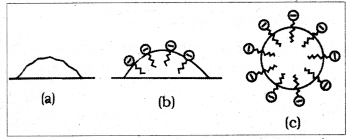
Since the polar group can interact with water, the oil droplet surrounded hydrocarbon part is pulled into water and is removed from the dirty surface. Thus soap emulsifies the oil and washes it out.
Question 123.
Describe Bredig’s arc method of preparation of colloids with a neat diagram.
Answer:
This process involves dispersion as well as condensation. In this method Electric arc is struck between electrodes of the metal immersed in the dispersion medium. The intense heat produced vapourises the metal which then condenses to form particles of colloidal size. Colloidal sols of metals such as gold, silver, platinum, etc. are prepared by this method.
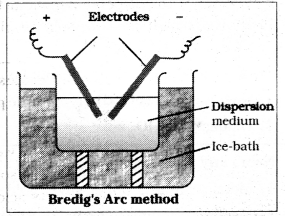
Question 124.
Name any four examples of colloids by chemical methods with necessary chemical equations.
Answer:
- AS2S3 sol can be prepared by double decomposition method.
AS2O3 + 3H2S AS2S3 (sol) + 3H2O
AS2S3 (sol) + 3H2O - Sulphur sol can be prepared by oxidation method.
SO2 + 2H2S 3S(sol) + 2H2O
3S(sol) + 2H2O - Gold sol can be prepared by reduction method.
2AuCl3 + 3HCH0 + 3H2O 2Au (sol) + 3HCOOH + 6HCl
2Au (sol) + 3HCOOH + 6HCl - Ferric hydroxide sol can be prepared by hydrolysis method.
FeCl3 + 3H2O Fe(OH3) + 3 HCl
Fe(OH3) + 3 HCl
![]()
Question 125.
Describe the purification of colloidal solutions by the phenomenon of dialysis with a neat diagram.
Answer:
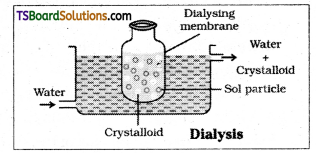
Dialysis is a process of removing a dissolved substance from a colloidal solution using a suitable membrane. The apparatus used for this purpose is called dialyser. A bag of suitable membrane containing the colloidal solution is suspended in a vessel containing a continous flow of water. The bag made with animal membrane, or parchment paper or cellophane sheet allow the molecules or ions to diffuse through it into the water and pure colloidal solution is left behind in the bag.
Question 126.
Explain the formation of micelles with a neat sketch.
Answer:
Certain substances behave as strong electrolytes at low concentrations but at higher concentrations exhibit colloidal behaviour due to the formation of aggregates. These aggregated particles are called micelles or associated colloids.
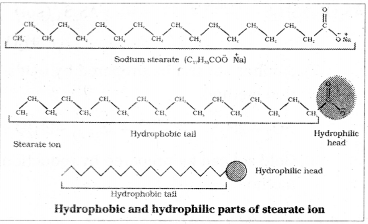
For example soap is a sodium or potassium salt of higher fatty acid and may be represented as RCOO– Na+ eg. sodium stearate CH3 (CH2)]6 COO– Na+, It dissociates into RCOO– and Na+ ions when dissolved in water. The RCOO– ions consists of two parts. The long hydrocarbon chain R (also called non polar tail) which is hydrophobic (water repelling) and a polar group COO– which is hydrophilic.
The RCOO– ions are therefore present with their COO– group into water and hydrocarbon chains (R) staying away from it and remain at the surface. At critical micelle concentration the COO– Ions are pulled into the bulk of the solution and are aggregated to form spherical shape with their hydrocarbon chain pointing towards the centre of sphere with COO– part remaining outward on the surface of the sphere. The aggregate thus formed is known as ionic micelle.
![]()
Question 127.
Action of soap is due to emulsification and micelle formation. Comment.
Answer:
The cleansing action of soap is due to the fact that soap molecules form a micelle around the oil droplet in such away that hydrophobic part of the stearate ions is in the oil droplet and hydrophilic part projects out of the grease droplet.
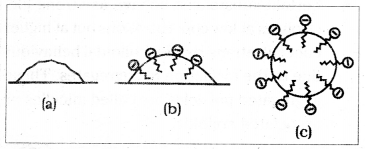
Since the polar groups can interact with water, the oil droplet surrounded by stearate ions is now pulled into water and is removed from the dirty surface. Thus soap helps in emulsification and washing away of oils and fats.
Question 128.
Explain the phenomenon of Brownian movement giving reasons for the occurrence of this phenomena.
Answer:
The colloidal particles in a colloid are in continuous zig-zag motion all over the field of view. This continous zig-zag motion of colloidal particles in a colloid is called as Brownian movement.
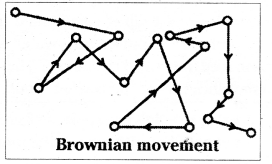
The Brownian movement is due to the bombardment of the molecules of dispersion medium on colloidal particles (dispered phase). The motion is independent of the nature of the colloid but depends on the size of the particles and viscosity of the solution.
Question 129.
Name any four positively charged sols.
Answer:
Positively charged sols.
- Hydrated metallic oxide sols e.g: Al2O3 . X H2O, CrO3 . X H2O and Fe2O3 . X H2O
- Basic dye stuffs eg. methylene blue sol
- Haemoglobin (blood)
- Oxides e.g : TiO2 sol
![]()
Question 130.
Name any four negatively charged sols.
Answer:
- Metal sols e.g.: Copper, silver, gold sols.
- Metallic sulphide sols e.g: AS2S3, Sb2S3, Cds etc.
- Acid dye stuff sols, e.g: eosin congo red sols.
- Sols of starch, gum, gelatin, clay, charcoal etc.
Question 131.
Explain the terms Helmholtz electrical double layer and zeta potential. What are their significances in the colloidal solutions ?
Answer:
In a colloid the colloidal particles acquire positive or negative charge by selective adsorption of ions on the surface of the colloidal particle. This positive or negative charge on colloidal particle attracts ions of opposite charge from the medium forming a second layer as shown below.
Agl/I– K+
AgI/Ag+ I–
The combination of the two layers of opposite charges around the colloidal particle is called Helmholtz electrical double layer. The first layer of ions is firmly held and is known as fixed layer while the second layer is mobile and is known as diffused layer. Between these two layers of opposite charges there develops a potential difference called electrokinetic potential or zeta potential.
The presence of equal and similar charges on colloidal particles is responsible for the stability of collodial solution. The repulsion between the colloidal particles having same charge keep them away and preventing them to come closer and coagulate.
Question 132.
Explain with a neat sketch the phenomenon of electrophoresis.
Answer:
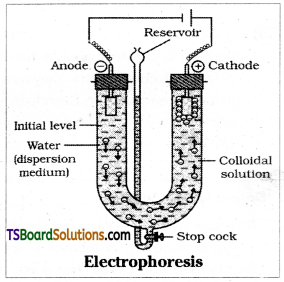
When electric potential is applied across two platinum electrodes dipping in a colloidal solution the colloidal particles move towards one or the other electrode. The movement of colloidal particles under the applied emf is called electrophoresis postively charged particles move towards the cathode while negatively charged particles move towards the anode.
![]()
Question 133.
Explain the following terms.
i) Electrophoresis
ii) Coagulation
iii) Tyndall effect
Answer:
i) Electrophoresis:
When electric potential is applied across two platinum electrodes dipping in a colloidal solution the colloidal particles move towards one or the other electrode. The movement of colloidal particles under the applied emf is called electrophoresis. Positively charged particles move towards the cathode while negatively charged particles move towards the anode.
ii) Coagulation:
The process of setting down of colloidal particles is called coagulation or precipitation or flocculation of the sol. When the charge on colloidal particles is neutralised, the colloidal particles come nearer to form aggregates and settles down under the force of gravity.
iii) Tyndall effect :
When light is passed through a colloidal solution the colloidal particles scatter the light in all directions in space. This scattering of light illuminates the path of beam in the colloidal dispersion. This is known as Tyndall effect.
Question 134.
Explain the phenomenon observed,
i) When a beam of light is passed through a colloidal sol.
ii) An electrolyte, NaCl is added to hydrated ferric oxide.
iii) An electric current is passed through a colloidal solution.
Answer:
i) When a beam of light is passed through a colloidal sol the colloidal particles scatter light in all directions in space. This scattering of light illuminates the path of beam in the colloidal dispersion. This is known as Tyndall effect.
ii) When NaCl is added, the colloidal particles are precipitated. This is because that colloidal particles interact with ions carrying opposite charge to that present on themselves. Then neutralisation of charges on colloidal particles takes place leading to their coagulation.
iii) When electric current is passed through a colloidal solution the colloidal particles move towards oppositely charged electrodes, get discharged and finally precipitated.
![]()
Question 135.
Describe Cottrell smoke precipitator with a neat diagram.
Answer:
Smoke is a colloidal solution of solid particles such as carbon, arsenic compounds, dust etc. in air. The smoke before coming out of chimney is passed through a precipitator containing plates having a charge opposite to that carried by smoke particles. The particles on coming in contact with these plates lose their charge and get precipitated. The particles thus settle down on the floor of the chamber. The precipitator is called Cottrell precipitator.
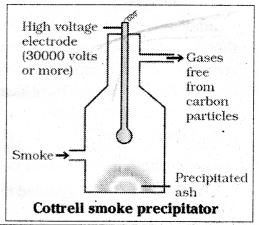
Question 36.
Among NaCl, Na2SO4 Na3 PO4 electrolytes which is more effective for coagulation of hydrated ferric oxide sol and why ?
Answer:
Hydrated ferric oxide sol carry positive charge. So it can be coagulated by adding an electrolyte that can neutralise the positive charge. Among NaCl, Na2SO4 and Na3PO4, Na3PO4 is more effective for coagulation because from Na3PO4 the PO43- ion formed can neutralize effectively. This is according to Hardy Schulze law which states that greater the valence of coagulating ion added the greater is its power to cause coagulation.
Question 137.
Discuss how a lyophilic colloid protect a lyophobic colliod.
Answer:
Lyophilic sols are more stable than lyophobic sols. In lyophilic colloids the particles are extensively solvated and covered by a layer of the dispersion medium. When a lyophilic colloid is added to a lyophobic sol the lyophilic particles form a protective layer around lyophobic particles and thus protect the latter from the action by electrolytes. Lyophilic colloids used for this purpose are called protective colloids.
![]()
Question 138.
Discuss the use of colloids in
i) Purification of drinking water
ii) Tanning
iii) Medicines
Answer:
i) Purification of drinking water :
Water obtained from natural sources contain colloidal particles. Alum is added to such water to coagulate the colloidal impurities and make water fit for drinking purposes.
ii) Tanning :
Animal skins are colloidal in nature. When the skin containing positively charged particles is soaked in tannin that contain negatively charged colloidal particles, mutual coagulation takes place. This makes the skin hard and the process is called Tanning.
iii) Medicines :
Most of the medicines are colloidal in nature. Colloidal medicines are more effective because they have large surface area and are therefore easily assimilated, e.g : Argyrol is a silver sol used as an eye lotion. Colloidal antimony is used in curing Kala azar.
Question 139.
Define Gold number.
Answer:
The protective power of protective colloids (lyophilic colloids) is measured by gold number. It is defined as “the mass in mill-grams which protects the coagulation of 10 ml of a gold sol on adding 1 ml of 10% NaCl solution”.
![]()
Question 140.
How do emulsifiers stabilize emulsion ? Name two emulsifiers.
Answer:
Emulsions are unstable. For stablisation of emulsion, a third component called emulsifying agent is usually added. The emulsifiying agent forms an interfacial film between suspended particles and the medium.
- Proteins are emulsifying agent for o/w type emulsions.
- Heavy metal salts of fatty acids, long chain alcohols, lamp black, etc. are emulsifying agents for w/o type emulsion.
Long Answer Questions (8 Marks)
Question 141.
Explain the terms absorption, adsorption and sorption. Describe the different types of absorption. [AP ’15]
Answer:
Absorption :
Uniform distribution of a substance through out the bulk of the solid is called absorption. For example, when a sponge or chalk piece is dipped in water, it distributes uniformly throughout the sponge or chalk piece due to absorption.
Adsorption:
The accumulation of molecular species at the surface rather than in the bulk of a solid or liquid is termed as adsorption. The substance which accumulates on the surface is called adsorbate and the material oh which the adsorption take place is called adsorbent.
Sorption :
If adsorption and absorption takes place simultaneously, it is known as sorption.
Adsorption is two types 1) Physical adsorption or physisorption and 2) Chemical adsorption or chemisorption.
Physisorption:
- It is due to the adsorption of a gas on a solid surface due to weak van der Waal’s forces.
- It is universal and lacks of specificity.
- The gases which have high critical temperatures adsorb easily.
- It is reversible and increases with increase in pressure and decrease in temperature.
- The enthalpy of physisorption is low.
Chemisorption:
- If the adsorption of a gas on a solid surface takes due to chemical bonds, it is called chemisorption.
- It involves high energy of activation.
- Physical adsorption at low temperature may convert into chemical adsorption at high temperature.
- It is highly specific in nature and is irreversible in nature.
- The enthalpy of chemisorption is high since it involves chemical bond formation.
![]()
Question 142.
Discuss the characteristics of physical adsorption.
Answer:
Characteristics of physical adsorption.
i) Lack of specificity:
Since Van der Waal’s forces are universal thefe is no specificity for physical adsorption. Any gas can be absorbed on any solid.
ii) Nature of adsorbate :
The amount of gas adsorbed by a solid depends on the nature of gas. Easily liquefiable gases which have high critical temperatures are readily adsorbed. This is because van der Waal’s forces are stronger near the critical temperature.
iii) Reversibilty :
Physical adsorption of a gas by a solid is generally reversible. With increase in pressure and decrease in te’mperatue adsorption increases. This is because adsorption decreases the volume of gas and adsorption is exothermic. With decrease in pressure and increase in temperature adsorption decreases. This is accroding to Le chatelier’s principle.
iv) Surface area of adsorbent:
More the surface area more is adsorption. Finely divided metals and porous substances having more surface area adsorbs more amount of gases.
v) Enthalpy of adsorption:
Since van der Waal’s forces are weak the enthalpy of physical adsorption is quite low (20 – 40 kJ mol-1).
Question 143.
Discuss the characteristics of chemisorption.
Answer:
Characteristics of Chemisorption :
i) High specificity :
Chemisorption is highly specific. It will occur only if there is possibility for the formation of chemical bonds between adsorbate and adsorbent.
ii) Irreversibility:
The chemical adsorption is due to compound formation i.e., due to chemical reaction. It is slow at low temperatures but increases with increase in temperature because the chemical reaction between adsorbent and adsorbate requires some energy of activation.
The physical adsorption taking place at low temperature may convert into chemical adsorption at a high temperature usually high pressures are favourable for chemisorption.
iii) Surface area:
With increase in surface area chemical adsorption increases.
iv) Enthalpy of adsorption :
Since chemisorption involves chemical bond formation, the enthalpy of chemisorption is also high (80 – 240 kJ mol-1).
![]()
Question 144.
Compare and contrast the phenomenon of physisorption and chemisorption.
Answer:
| Physisorption | Chemisorption |
| 1. It arises because of van der Waals’ forces. | 1. It is caused by chemical bond formation. |
| 2. It is not specific in nature. | 2. It is highly specific in nature. |
| 3. It is reversible in nature. | 3. It is irreversible. |
| 4. It depends on the nature of gas. Easily liquefiable gases are adsorbed readily. | 4. It also depends on the nature of gas. Gases which can react with the absorbent show chemisorption. |
| 5. Enthalpy of adsorption is low (20 – 40 kJ mol-1). | 5. Enthalpy of adsorption is high (80 – 240 kJ mol-1). |
| 6. Low temperature is favourable for adsorption. It decreases with increase of temperature. | 6. High temperature is favourable for adsorption. It increases with the increase of temperature. |
| 7. No appreciable activation energy is needed. | 7. High activation energy is sometimes needed. |
| 8. It depends on the surface area. It increases with an increase of surface area. | 8. It also depends on the surface area. It too increases with an increase of surface area. |
| 9. It results into multimolecular layers on adsorbent surface under high pressure. | 9. It results into unimolecular layer only. |
Question 145.
What is an adsorption isotherm ? Discuss the phenomenon of adsorption of gases on solids with the help of Freundlich adsorption isotherm.
Answer:
The variation in the amount of gas adsorbed by the adsorbent with pressure at constant temperature can be expressed by means of a curve called as adsorption isotherm.
Freundlich adsorption isotherm :
It gives the empirical relationship between the quantity of gas adsorbed by unit mass of solid adsorbent and pressure at a particular temperature. The relationship can be expressed as
\(\frac{\mathrm{x}}{\mathrm{m}}\) = k . p1/n (n > 1) ……………….. (1)
where x is the mass of gas adsorbed
m is the mass of adsorbent
p is pressure
k and n are constants which depend on the nature of gas and the adsorbent at a particular temperature.
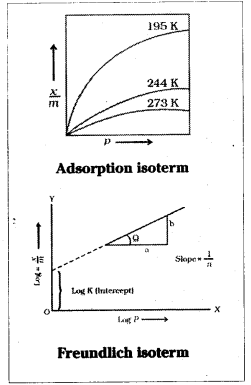
The curves in the graph indicate that at constant pressure, there is decrease in physical adsorption with increase in pressure.
Taking logarithms of equation (1)
log \(\frac{\mathrm{x}}{\mathrm{m}}\) = log k + \(\frac{\mathrm{1}}{\mathrm{n}}\) log p …………… (2)
on plotting log \(\frac{\mathrm{x}}{\mathrm{m}}\) on y – axis and log p on x axis if a straight line is obtained Freundlich isotherm is valid. The slope of the straight line gives the value of \(\frac{\mathrm{1}}{\mathrm{n}}\). The intercept on n the y – axis give the value of log k.
The factor \(\frac{\mathrm{1}}{\mathrm{n}}\) can have values 0 and 1. Thus equation 2 holds good over a limited range of pressures when \(\frac{\mathrm{1}}{\mathrm{n}}\) = 0, \(\frac{\mathrm{x}}{\mathrm{m}}\) = constant
the adsorption is independent of pressure,
when \(\frac{\mathrm{1}}{\mathrm{n}}\) = 1, \(\frac{\mathrm{x}}{\mathrm{m}}\) = k.p i.e, \(\frac{\mathrm{x}}{\mathrm{m}}\) ∝ p. The adsorption varies directly with pressure. Freundlich adsorption isotherm fails at high pressures.
![]()
Question 146.
Give a detailed account of applications of adsorption.
Answer:
The adsorption phenomenon have a number of applications.
- Production of high vacuum: The traces of air remained in a vessel after evacuation by a vacuum pump can be removed by adsorbing on charcoal to give high vacuum.
- Gas masks : Gas masks consisting of activated charcoal or mixture of adsorbents adsorb poisonous gases during breathing. These are mainly used by coal miners.
- Control of humidity : The mositure in air can be decreased by adsorbing it on silica gel or alumina gel thus the humidity in a room can be controlled.
- Removal of coloured substances: Animal charcoal removes colours of impure coloured solution by adsorbing impurities.
- Heterogeneous catalysis : Reactant molecules adsorb on the solid catalyst and decrease to activation energy. Thus the reaction proceed fastly.
- Separation of Inert gases : The inert gases can be separated by adsorbing them on coconut charcoal at different tempe-ratures. This process depends on the difference in the degree of adsorption of gases.
- In curing diseases : Several drugs kill germs by adsorbing on germs.
- Froth floatation process: Sulphide ores are concentrated by this method.
Question 147.
What is catalysis ? How is catalysis classified ? Give four examples for each type of catalysis.
Answer:
Substances which accelerate the rate of a slow chemical reaction but whose chemical nature and mass remain unchanged after the reaction are known as catalysts and the phenomenon is known as catalysis.
Catalysis can be broadly divided into two groups.
I) Homogeneous catalysis: When the reactants and the catalyst are in the same phase, i.e., either in liquid or in gas phase, the process is said to be homogeneous catalysis.
Examples:
1) Oxidation of SO2 to SO3 in the presence of oxides of nitrogen.
![]()
SO2, O2 and the catalyst NO are all gases and are in same phase.
2) Hydrolysis of methyl acetate catalysed by H+.
CH3COOCH3CO + H2O (l) ![]() CH3 COOH (aq) + CH3OH (aq)
CH3 COOH (aq) + CH3OH (aq)
Both reactants and the catalyst are in same liquid phase.
3) Hydrolysis of sugar catalysed by H+.

4) In the oxidation of oxalic acid with aqueous KMnO4 in acid medium Mn2+ ion formed during the reaction act as catalyst.
2KMnO4 (aq) + 3H2SO4 (aq) + 3H2C2O4 (aq) →K2SO4 (aq) + 2MnSO4 (aq) + 8H2O (l) + 10CO2 (g)
II) Heterogeneous catalysis: The catalytic process in which the reactants and the catalyst are in different phases is known as heterogeneous catalysis.
Examples:
1) Oxidation of SO2 to SO3 in the presence of Pt.
![]()
2) Synthesis of ammonia by the reaction of N2 gas and H2 gas in the presence of solid iron powder catalyst in Haber’s process.
![]()
3) Oxidation of ammonia to nitric oxide in the platinum gauze.
![]()
4) Hydrogenation of vegetable oils in the presence of solid nickel as catalyst.
![]()
![]()
Question 148.
Discuss the mechanism of heterogeneous catalysis.
Answer:
As per old theory the reactant molecules in the gaseous state or in solutions are adsorbed on the surface of the solid catalyst. The increase in concentration of the reactants on the surface increase the rate of reaction. The heat liberated during adsorption is also utilised in increasing the rate of reaction.
According to modern theory.
- Reactant molecules diffuse on to the surface of catalyst.
- The reactant molecules adsorb on the surface of the catalyst.
- Chemical reaction takes place between adsorbed reactant molecules through formation of an intermediate.
- The product molecules desorb from the catalyst surface making the surface available for more reaction to occur.
- The product molecules diffuse away from the surface of the catalyst for the adsorption of fresh reactant molecules.
Question 149.
What are enzymes ? Explain in detail the enzyme catalysis with necessary examples.
Answer:
Enzymes are complex nitrogeneous organic . compounds which are produced by living plants and animals. They are mainly protein molecules of high molecular mass and form ‘ colloidal solutions in water. These catalyse numerous reactions that occurs in plants and animals. So they are termed as bio-chemical catalysts and the phenomenon is known as biochemical catalysis.
Mechanism of enzyme catalysed reaction :
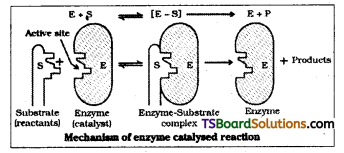
There are a number of cavities present on the surface of colloidal particles of enzymes. These cavities are of characteristic shape and possess active groups such as -NH2, – COOH, -SH -OH etc. These are the active centres on the surface of enzyme particles. The molecules of the reactant which have complimentary shape fit into these cavities just like a key fits into a lock. The reactant molecule combine with active groups forming an activated complex which decomposes into the products. These reactions may be considered to proceed in two steps.
- To form an activated complex
E + S → ES# - Decomposition of activated complex to give the product
ES# → E + P
Examples:
1) Inversion of cane sugar in the presence of invertase.

2) Conversion of glucose into ethyl alcohol in the presence of zymase.

![]()
Question 150.
What are colloidal solutions ? How they are classified ? Give examples.
Answer:
A colloidal solution is a heterogeneous system in which one substance is dispersed (dispersed phase) as large particles in another substance (dispersion medium).
Colloids are classified on the basis of the following criteria.
i) Physical states of the dispersed phase and the dispersion medium.
| Dispersed phase | Dispersion medium | Type of colloid | Examples |
| Solid | Solid | Solid sol | some coloured glasses and gem stones |
| Solid | Liquid | Sol | Paints, cell fluids |
| Solid | Gas | Aerosol | Smoke, dust |
| Liquid | Solid | Gel | Cheese, butter, jellies |
| Liquid | Liquid | Emulsion | Milk, hair cream |
| Liquid | Gas | Aerosol | Fog, mist, cloud, insecticide sprays |
| Gas | Solid | Solid sol | Pumice stone, foam rubber |
| Gas | Liquid | Foam | Froth, whipped cream, soap lather |
ii) Nature of the interaction between the dispersed phase and the dispersion medium.
Depending upon the nature of interaction between the dispersed phase and dispersion medium the colloidal sols are classified into two types.
a) Lyophilic colloids:
If there is attraction between the dispersion medium and dispersed phase, the colloids are called as lyophilic colloids. Lyophilic means solvent loving or solvent attracting. These can be prepared by direct mixing and can be separated from one another by evaporating. These sols are reversible, so called reversible sols. These are stable and cannot be easily coagulated.
b) Lyophobic colloids :
If there is repulsion between dispersion medium and dispersed phase, the colloids are called lyophobic colloids. Lyophobic means solvent hating. This type of colloids cannot be prepared simply by mixing. They have to be prepared by special methods. These sols are readily precipitated by the addition of small amounts of electrolytes or by heating. The precipitate does not give back the colloidal sol by simple addition of the dispersion medium to it. So these are known as irreversible sols. Lyophobic sols need stabilising agents for their preservation.
If water is the dispersion medium these are called hydrophilic and hydrophobic colloids.
iii) Type of particles of the dispersed phase: :
Depending upon the type of the particles of the dispersed phase colloids are classified as multimolecular, macro. molecular and associated colloids.
a) Multimolecular colloids contain aggregates of atoms or molecules of dispersed phase to from particles of colloidal size, eg: Sulphur sol.
b) Macromolecular colloids contain dispersed phase of macromolecules of colloidal range. e.g. : Starch, cellulose, proteins and enzymes etc.
c) Associated colloids contain aggregates of long non polar hydrocarbon chain along with polar groups such as COOHSO3H. The hydrocarbon chain is hydrophylic end and polar group is hydrophobic end. These aggregated particles formed are called micelles and also known as associated colloid.
![]()
Question 151.
How are colloids classified on the basis of the nature of interaction between a dispersed phase and a dispersion medium ? Describe an important characteristic of each class. Which of the sols need stabilising agents for preservation ?
Answer:
Nature of the interaction between the dis-persed phase and the dispersion medium.
Depending upon the nature of inter-action between the dispersed phase and dispersion medium the colloidal sols are classified into two types.
a) Lyophilic colloids:
If there is attraction between the dispersion medium and dispersed phase, the colloids are called as lyophilic colloids. Lyophilic means solvent loving or solvent attracting. These can be prepared by direct mixing and can be separated from one another by evaporating. These sols are reversible, so called reversible sols. These are stable and cannot be easily coagulated.
b) Lyophobic colloids :
If there is repulsion between dispersion medium and dispersed phase, the colloids are called lyophobic colloids. Lyophobic means solvent hating. This type of colloids cannot be prepared simply by mixing. They have to be prepared by special methods.
These sols are readily precipitated by the addition of small amounts of electrolytes or by heating. The precipitate does not give back the colloidal sol by simple addition of the dispersion medium to it. So these are known as irreversible sols. Lyophobic sols need stabilising agents for their preservation.
If water is the dispersion medium these are called hydrophilic and hydrophobic colloids.
Question 152.
What are micelles ? Discuss the mechanism of micelle formation and cleaning action of soap.
Answer:
Micelles and Mechanisim of micelle for-mation : Certain substances behave as strong electrolytes at low concentrations but at higher concentrations exhibit colloidal behaviour due to the formation of aggregates. These aggregated particles are called micelles or associated colloids.
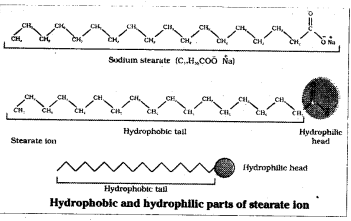
For example soap is a sodium or potassium salt of higher fatty acid and may be represented as RCOC– Na+ eg. sodium stearate CH3 (CH2)16 COO– Na+. It dissociates into RCOO– and Na+ ions when dissolved in water. The RCOO– ions consists of two parts. The long hydrocarbon chain R (also called non polar tail) which is hydrophobic (water repelling) and a polar group COO– which is hydrophilic.
The RCOO– ions are therefore present with their COO– group into water and hydrocarbon chains (R) staying away from it and remain at the surface. At critical micelle concentration the COO– Ions are pulled into the bulk of the solution and are aggregated to form spherical shape with their hydrocarbon chain pointing towards the centre of sphere with COO– part remaining outward on the surface of the sphere. The aggregate thus formed is known as ionic micelle.
Cleaning Action:
The cleansing action of soap is due to the fact that soap molecules form a micelle around the oil droplet in such away that hydrophobic part of the stearate ions is in the oil droplet and hydrophilic part projects out of the grease droplet.
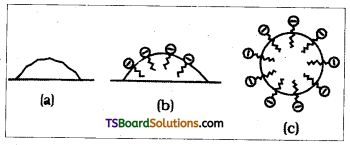
Since the polar groups can interact with water, the oil droplet surrounded by stearate ions is now pulled into water and is removed from the dirty surface. Thus soap helps in emulsification and washing away of oils and fats.
![]()
Question 153.
Describe the properties of colloids with necessary diagrams wherever necessary.
Answer:
1) Colligative properties:
Since the colloidal particles are aggregates of small particles, the number of particles in colloidal solution is comparatively less than those in true solution. So the values of colligative properties such as lowering of vapour pressure, elevation in boiling point, depression in freezing point and osmotic pressure are lesser than those shown by true solution at same concentration.
2) Optical properties :
When a beam of light is passed through a colloidal solution the colloidal particles scatter the light in all directions. This scattering of light illuminates the path of beam in colloidal dispersion. This is known as tyndall effect. The bright cone of the light is called Tyndall cone.
Tyndall effect is observed only when the following two conditions are satisfied.
- The diameter of the colloidal particle should not be much smaller than the wave length of the light used.
- The refractive indices of the dispersed phase and the dispersion medium should differ greatly in magnitude.
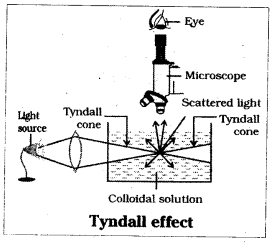
3) Colour :
Colour of colloidal solution depends on the wavelength of light scattered by the colloidal particles. The wavelength depends on the size and shape of the colloidal particle. Large particles scatter shorter wavelength light and vice versa. Spherical particles scatter red light and disc like particles scatter blue light.
The colour of the colloid changes from the direction it is viewed.
4) Kinetic property:
The colloidal particles are in continous zig-zag motion due to bombardment of the molecules of the dispersion medium on collodial particles.
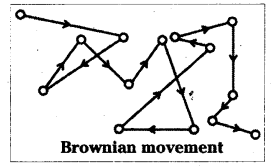
The motion of colloidal particle is independent of the nature of the colloid but depends on the size of the particles and viscosity of the solution.
5) Electrical properties:
Colloidal particles. always carry an electric charge. The charge on the colloidal particle is considered as a fixed layer. It attracts the opposite charge in the solution which forms a second diffused layer. Between these two oppositely charged layers a potential difference arises. This is known as electrokinetic or zeta potential.
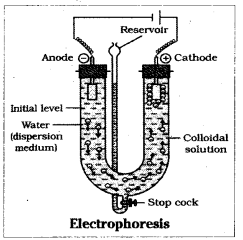
When an emf is applied the colloidal particles move towards cathode or anode depending on the charge present on it. It is known as electrophoresis.
If the movement of colloidal particles is arrested by some suitable means, the dispersion medium moves in the opposite direction. This is known as electro-osmosis.
6) Coagulation or precipitation :
If the charge on the colloidal particles is neutralised by adding a suitable oppositely charged ion, the colloidal particles coagulates or precipitates.
![]()
Question 154.
What are emulsions ? How are they classified ? Describe the applications of emulsions. [AP ’17 ; TS ’16]
Answer:
Emulsions are liquid – liquid colloidal system. The dispersion of finely divided droplets in another liquid emulsion. The emulsions are two types.
- Oil dispersed in water (o/w)
- Water dispersed in oil (w/o)
a) In o/w type emulsions water is the dispersion medium and oil is dispersion phase eg. milk and vanishing cream.
b) In w/o type emulsions oil is the dispersion medium and water is dispersion phase, eg ; butter
Applications of emulsions:
Emulsions are useful
(a) in the digestion of fats in intestines
(b) in washing processes of clothes and crockery
(c) in the preparation of lotions, creams, ointments in pharmaceuticals and cosmotics
(d) in the extraction of metals
(e) in the conversion of cream into butter by churning.
Intext Questions – Answers
Question 1.
Write any two characteristics of chemisorption.
Answer:
- Chemisorption is highly specific. It will occur only when there is possibility of chemical bonding between adsorbent and adsorbate.
- Enthalpy of chemisorption is high (80 – 240 kJmol-1) since it involves bond formation.
![]()
Question 2.
Why does physisorption decrease with increase in temperature ?
Answer:
Adsorption is exothermic process. So according to Le-Chatelier’s principle physical adsorption occurs readily at low temperature and decreases with increasing temperature.
Question 3.
Why are finely powdered substances more effective adsorbents than their non powdered crystal forms ?
Answer:
The extent of adsorption increases with the increase of surface area of the adsorbent. Thus finely divided metals and porous substances having large surface areas are good adsorbents.
Question 4.
Hydrogen used in Haber’s process is obtained by reacting methane with steam in presence of NiO as catalyst. The process is known as steam reforming. Why is it necessary to remove CO formed in steam reforming when ammonia is obtained by Haber’s process ?
Answer:
The CO present in hydrogen act as poison to the molybdenum acting as promoter for iron which is used as catalyst. So it is necessary to remove CO from H2 obtained by steam reforming during the manufacture of ammonia by Haber’s process.
Question 5.
Why is ester hydrolysis slow in the beginning but is fast after sometime ?
Answer:
Ester hydrolysis is slow in the beginning and becomes faster after sometime. This is because of the formation of acetic acid during the reaction which act as catalyst.
![]()
Question 6.
What is the role of desorption in the process of adsorption catalysts ?
Answer:
Desorption of reaction products from the surface of catalyst and there by making the surface available again for adsorption of reactants. Thus more reactions takes place.
Question 7.
What modification can you suggest in the Hardy – Schulze law ?
Answer:
Hardy-Schulze law states that greater the valence of the coagulating ion added, greater is its power to cause coagulation. Instead of valence by using charge we can say greater the charge on the coagulating ion added more is its coagulating power.
Question 8.
Why is it essential to wash the precipitate in gravimetric chemical analysis with wash liquid before drying and weighing it quantitatively ?
Answer:
The ions present in the solution will be adsorbed on the solid precipitate in gravimetric chemical analysis. This gives erronious results. On washing the precipitate with wash liquid before drying and weighing it quantitatively the adsorbed ions will be removed.

